The History of the Rolex Air-King, The Understated Pilot’s Watch
Far from the popularity of some of the brand’s icons, but still a fascinating and long-lasting collection.
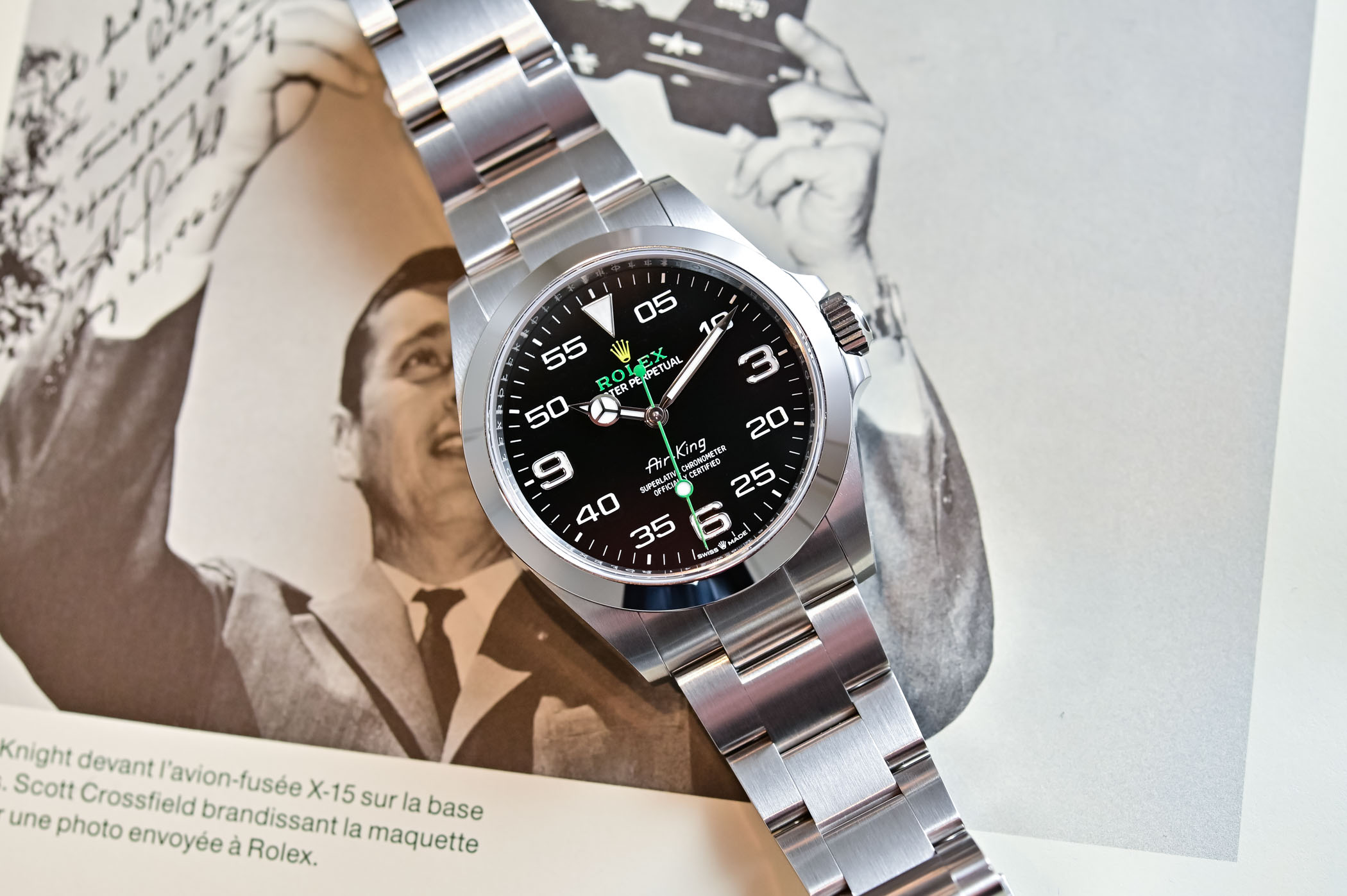
The Air-King is an interesting model within Rolex’s historic portfolio (known as an evergreen if it’s still in production), sometimes dismissed as too entry-level (well, back in the day). The sentiment is somewhat understandable but also misplaced, even if the Air-King sits among the most affordable models on the preowned market today. The watch goes back to the end of World War II with origins that are downright cool, debuting in 1945 to honour British pilots. It’s not a traditional pilot’s watch per se and was more of a tribute, but has evolved into a special series in today’s lineup. It’s also among the oldest of all Rolex models, beating the Explorer, Submariner, GMT-Master, Day-Date and more to the punch. That said, the legendary Datejust also debuted in 1945. Continuing our series of articles about historical Rolex models, we now look at the underappreciated Rolex Air-King.
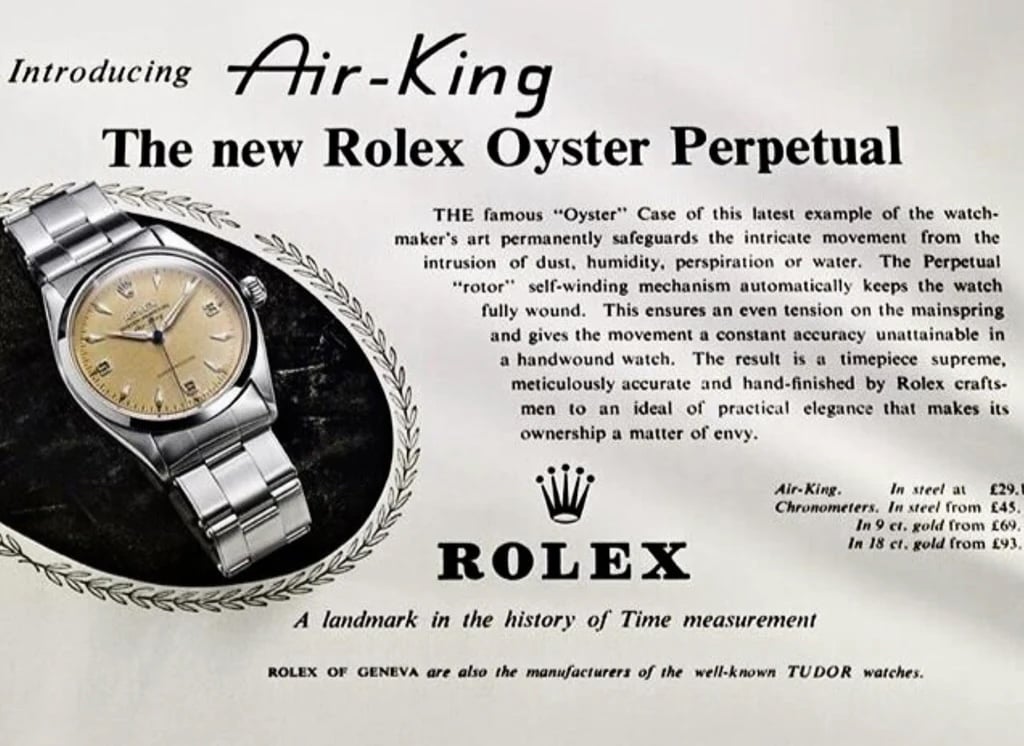
British Royal Air Force
The Air-King was actually part of a broader series of four “Air” models to honour the British Royal Air Force (RAF) with the other three being the Air-Lion, Air-Tiger and Air-Giant. All were similar and the latter three came first (starting in the 1930s) and have long since vanished, leaving the Air-King as the proverbial king of the mountain. Original Air-Kings shared a lot of DNA with early pieces like the Milgauss and Oyster Perpetual, and sometimes they were literally the same watch with some dial variances. Early Air-Kings looked very different from the familiar, simple aesthetic that ran for decades, but like a lot of the crown’s models, experimentation was just par for the course until things were dialled in. Images below by Bonhams.com.
The Air-King Reference 4925, The Hand-Wound Era (1945 – 1953)
This initial Air-King again looked very different from typical models from ref. 5500 (1957 – 1989) and could be mistaken for another model entirely without Air-King being printed on the dial. However, the DNA was there from the start with a 34mm stainless steel (Bubbleback) Oyster case, screw-down crown, respectable (for the time) 50 metres of water resistance and drilled lugs. The dial was an eggshell colour with shallow applied Arabic numerals (gold colour) in an avant-garde font. The Rolex crown was printed under 12 o’clock with ROLEX underneath and OYSTER AIR-KING under that. And that was all there was to it, other than a simple track of matching applied dots spanning the perimeter. Later 4925 models had SWISS MADE printed at the very bottom, but it seems early 1945 dials may have skipped this. Matching (colour) leaf hour and minute hands were used under an acrylic crystal with a blued seconds hand, offering reasonable legibility in a simple, straightforward package. Not quite a pilot’s watch, but again one to honour RAF pilots who flew during the war.
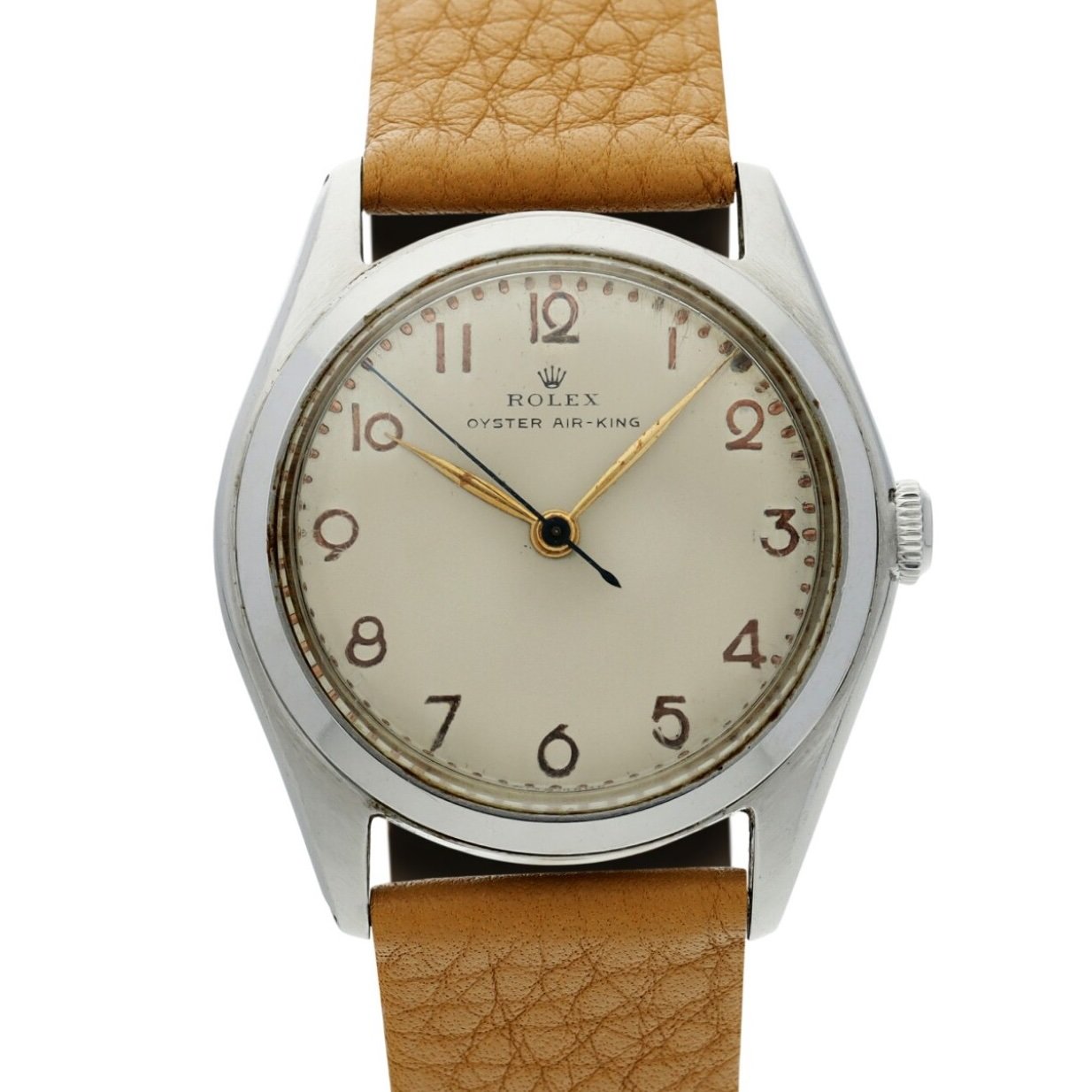
Although the Oyster Perpetual debuted in 1931 with the pairing of the Oyster case and automatic calibre 620 (the Oyster Perpetual name might’ve waited until 1932), the Air-King started life with a more modest hand-wound Hunter movement from Aegler, calibre 10.5. It had 15 jewels and beat at a standard (for the time) 18,000vph or 2.5Hz, and was not a chronometer or even finely adjusted. Despite not having a rotor, the case was a shared Bubbleback design to accommodate automatic counterparts, again why some other Rolex models are identical save for the dial. It was a reliable, perfectly adequate and affordable workhorse, but was upgraded a year later with ref. 4499 that actually ran alongside ref. 4925 until both were discontinued in 1953. It should be noted that Rolex automatics prior to calibre 1030 in 1950 were based on Hunter movements with added modules for the rotor. So, the thicker calibres that resulted again needed the Bubbleback case and Rolex wasn’t going to design a new one just for the Air-King.
The Air-King Reference 4365 (1945 – 1953)
This reference and ref. 4925 basically ran together from start to finish, but the differences between the two were surprisingly stark. For starters, ref. 4365 had a large small seconds sub-dial in lieu of central hands, so they used different hand-wound movements (although both based on calibre 10.5). The reasoning is that it was also made as Air-Lion and Air-Giant models, so the differentiation makes sense. It shares dial features with both ref. 4925 and the upcoming ref. 4499, starting with the flat applied indices of ref. 4925 but a more contemporary printed outer track that’s continued on ref. 4499. PRECISION is now printed on the dial like ref. 4499, but tightly wedged between the top of the sub-dial and central hands. It indicates a slightly improved variant of calibre 10.5 that most likely went to 17 jewels from 15 (also seen with ref. 4499 with its updated calibre 10.5, but with a central seconds hand). The leaf hands were also narrower than ref. 4925, just like ref. 4499, along with the addition of SWISS MADE at the bottom of all dials.
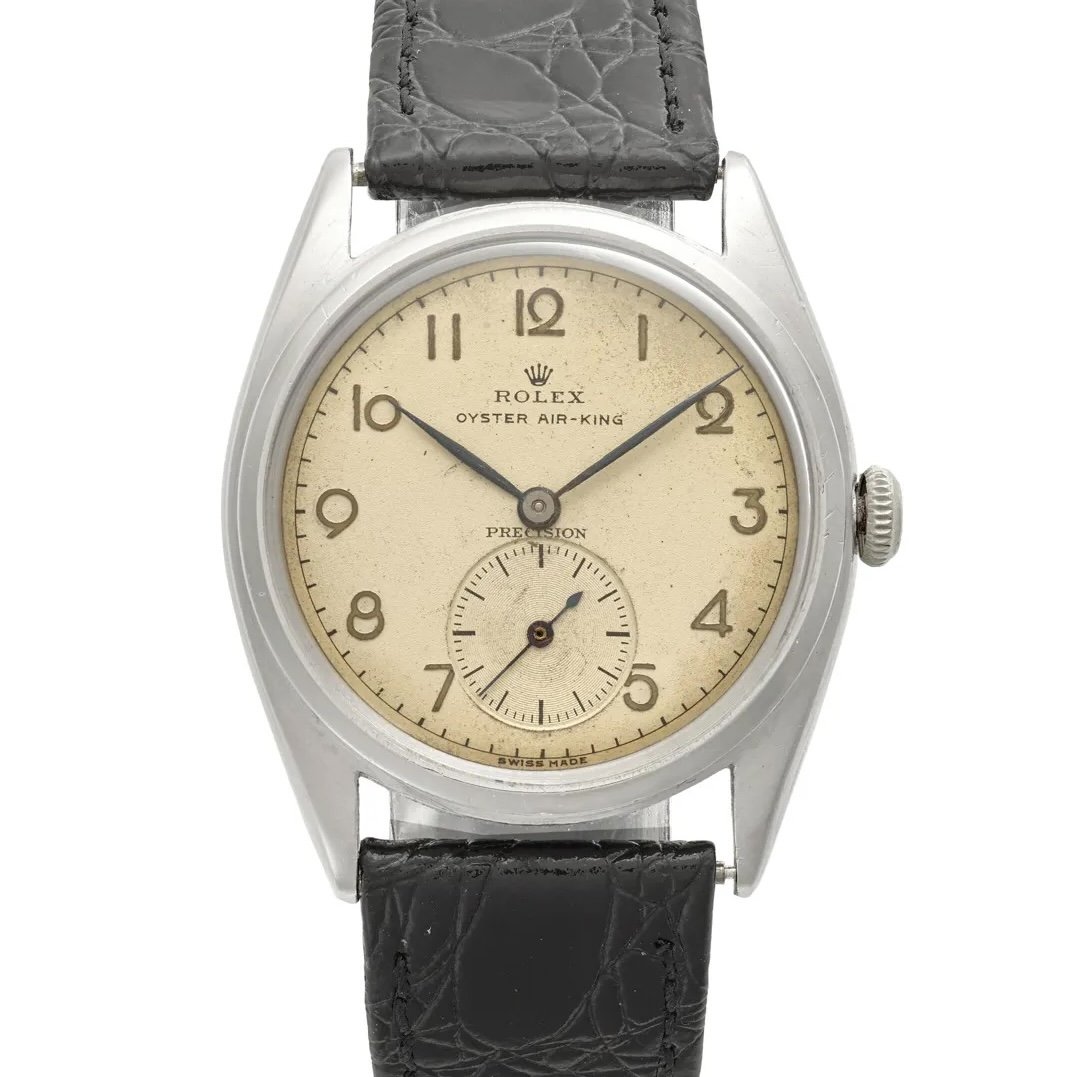
The Air-King Reference 4499 (1946-1953)
This is arguably the next actual Air-King after ref. 4925 as ref. 4365 was shared across multiple Air models. It wasn’t a big change from the original piece, but there are several notable differences. The applied indices had the same font, but were narrower, taller and black instead of gold. The more detailed and conventional printed minute/seconds track from ref. 4365 returned along with PRECISION, now printed comfortably above 6 o’clock without obstacles. SWISS MADE again appeared at the bottom of the dial, which would be a permanent fixture moving forward. The same (or very similar) leaf hands from ref. 4365 are also here in black and combined with the darker, more pronounced indices, legibility significantly improved. This reference represented a maturity of the Air-King with better dial elements and an updated calibre 10.5 with 17 jewels and all central hands.
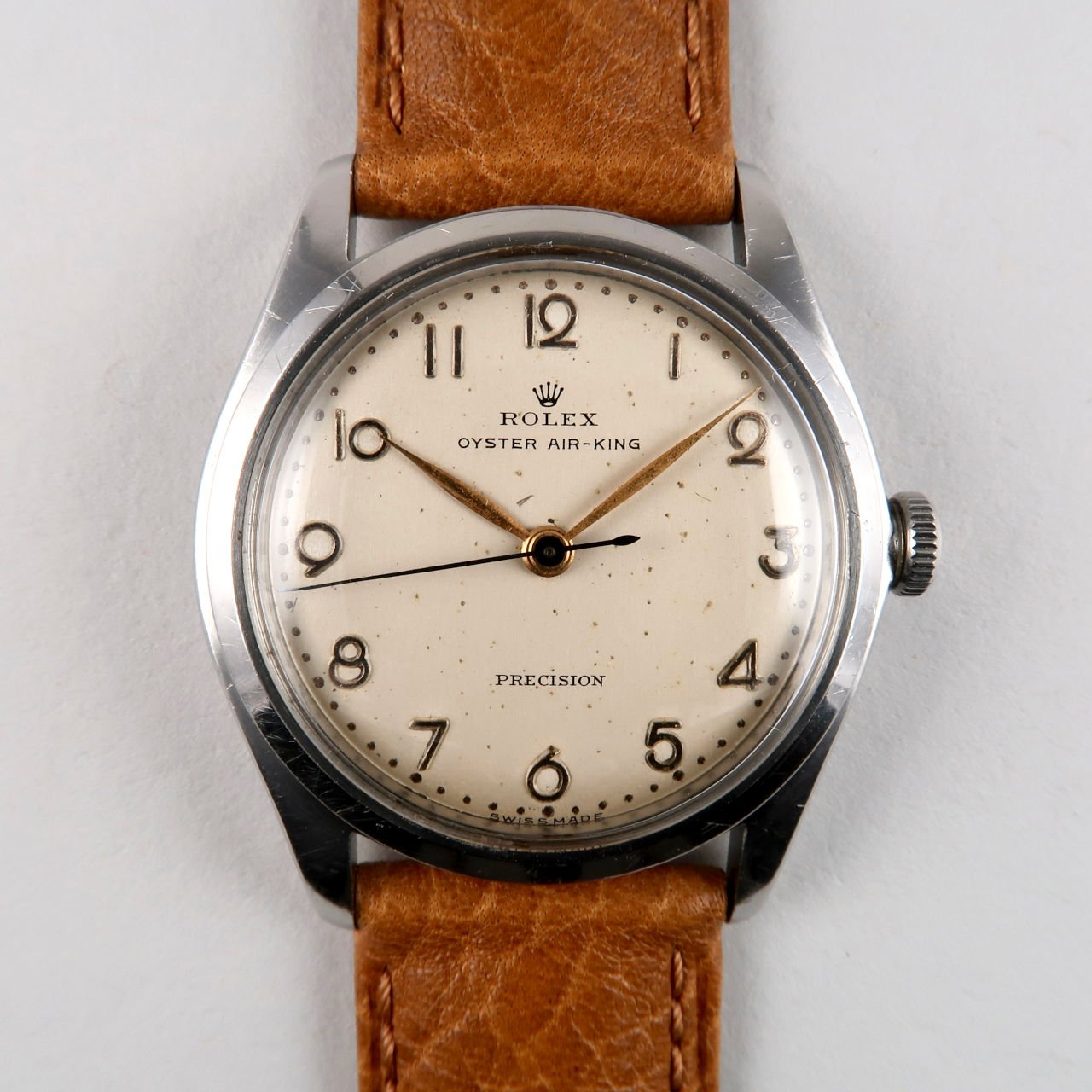
Remember when I said that Air-Kings were sometimes identical to other Rolex models save for dial print? Well, some models early on actually shared the reference number 4499 as well. It’s a bit hard to believe today, but in the early and mid-20th century, Rolex was disorganized when it came to cataloguing specific models, variances within references, exact calibre numbers and so on. It’s today’s collectors that tend to clarify details and fill in the gaps.
The Air-King Reference 6552 (1953 – 1957)
This was the first real leap for the Air-King with significant changes to the dial and movement. The dial layout doesn’t exactly represent what the Air-King would become, having polished and faceted “spear” indices and Explorer(ish) Arabic numerals at 3, 6 and 9 o’clock (although the latter does make a triumphant return). However, later 6552 dials would get the more classic stick indices that represented the future of the model. This is what it looks like when Rolex throws everything at the wall early on to see what sticks. Alpha hour and minute hands replaced their leaf counterparts and had radium lume inserts for the first time. PRECISION was replaced by SUPER PRECISION to indicate the new and improved automatic movement. The Rolex crown and ROLEX itself were now applied and Air-King was printed in the classic script for the first time (and not in all caps). What hadn’t changed were the 34mm case, acrylic crystal, drilled lugs and water resistance. The outer minute/seconds track also gained additional marks with a pattern of long and short for better timing. And finally, this was the first Air-King to start using the 3-link Oyster bracelet from the factory.
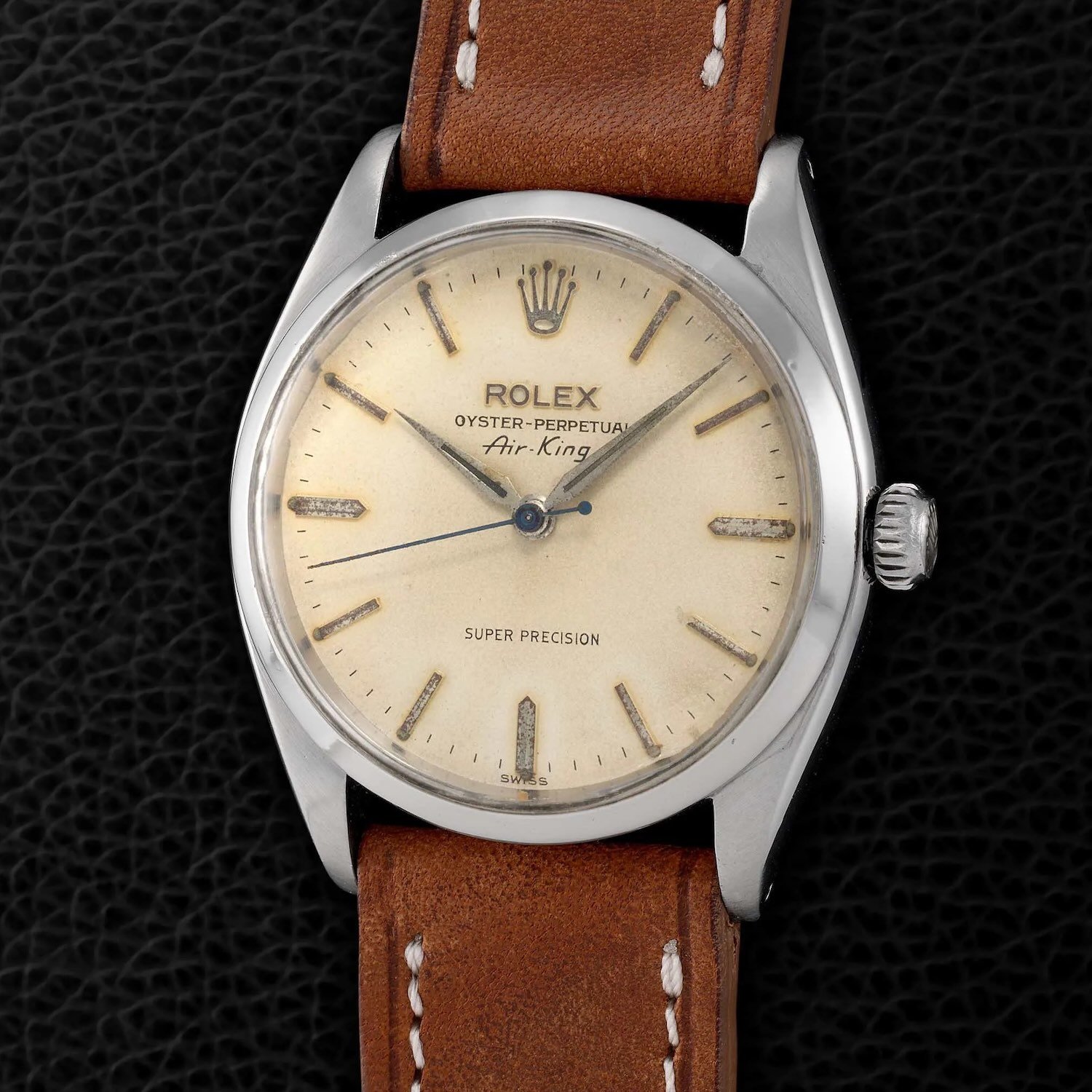
Calibre 1030 and the Dawn of In-House Production
The biggest change was under the hood with calibre 1030, transforming the Air-King into an Oyster Perpetual model. It still had a 2.5Hz beat rate, but also 25 jewels, better accuracy and it never toyed with the small seconds layout. This was the brand’s first fully realized in-house movement (launched in 1950) with a “butterfly” bi-directional rotor for better efficiency and an optional chronometer rating, and was also used in early Explorers and (no-date) Submariners. Prior Rolex automatics again used base Hunter movements with an added module for the rotor. Ref. 6552 was clearly not taking a back seat to other models with its new in-house Oyster Perpetual powers, establishing itself as a simple yet high-end watch that leaned to the dressy side without pretending to have sporty intentions.
The Air-King Reference 6652… Well Dude, We Just Don’t Know
This is supposedly a transitional Air-King with calibre 1030 leading up to ref. 5500, but there’s not a lot to go on. Many connoisseurs insist that it never actually existed, while others maintain it’s the product of Rolex’s early sloppiness with cataloging. Whether or not ref. 6652 is a bona fide Air-King or another model entirely isn’t exactly clear, but it’s often been intertwined with ref. 6552 and might even be the same model with the “wrong” reference number. That’s if it really exists at all. Just a little more Rolex lore (and forgive the Big Lebowski reference).
The Air-King Reference 5500, The Modern Air-King is Born (1957 – 1989)
This is the longest-running Air-King reference and represents the aesthetic that most Rolex collectors and enthusiasts think of. There were tweaks and updates during its 32-year run, but the general formula was now clearly established. The first modern Air-King was born, but it would continue to evolve into the 21st century with major changes. It remained smaller than the norm at 34mm in diameter when models like the Explorer and Datejust were 36mm. And talking about the Explorer, from 1958 to around 1967, there was a 5500 Explorer in this 34mm case (Explorers were otherwise 36mm). A typical Rolex experiment that resulted in an Air-King/Explorer hybrid that tried to leverage the best of both models in an affordable package – these were not certified chronometers like the certified Explorers 6610 or 1016 at the time. Like the Air-King, they had PRECISION on the dial instead of SUPERLATIVE CHRONOMETER OFFICIALLY CERTIFIED. Collectors dig them today and they’re among the hardest to find. However, many consider them Explorers instead of Air-Kings altogether and I tend to agree.
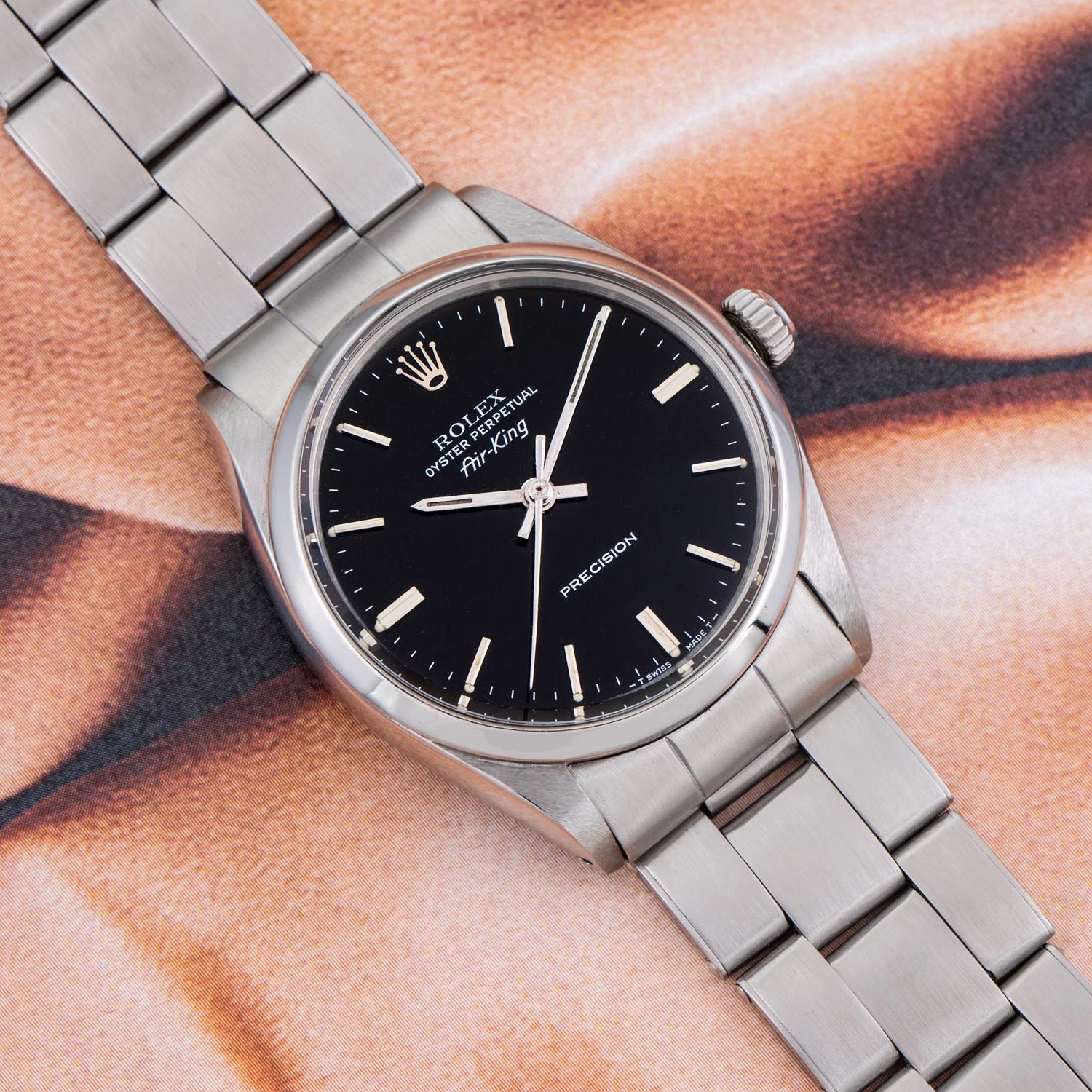
As a long running reference, variances are all over the map, starting with “Pre-Precision” models. Depending on the market, ref. 5500 models had either calibre 1520 or 1530 with the latter often having SUPER PRECISION on the dial over the 1520’s PRECISION. This was inconsistent, however, and some models had PRECISION or SUPER PRECISION regardless of movement, while a handful of early models had nothing at all, hence the “Pre-Precision” moniker. These are very rare today and prized by collectors. In addition to the scattershot nature of the day, service and repairs (and potential minor upgrades) resulted in inconsistencies with dial designations, movements and so on as well. Then there are rarities like the “double red” dials with Air-King and SUPER PRECISION printed in red.
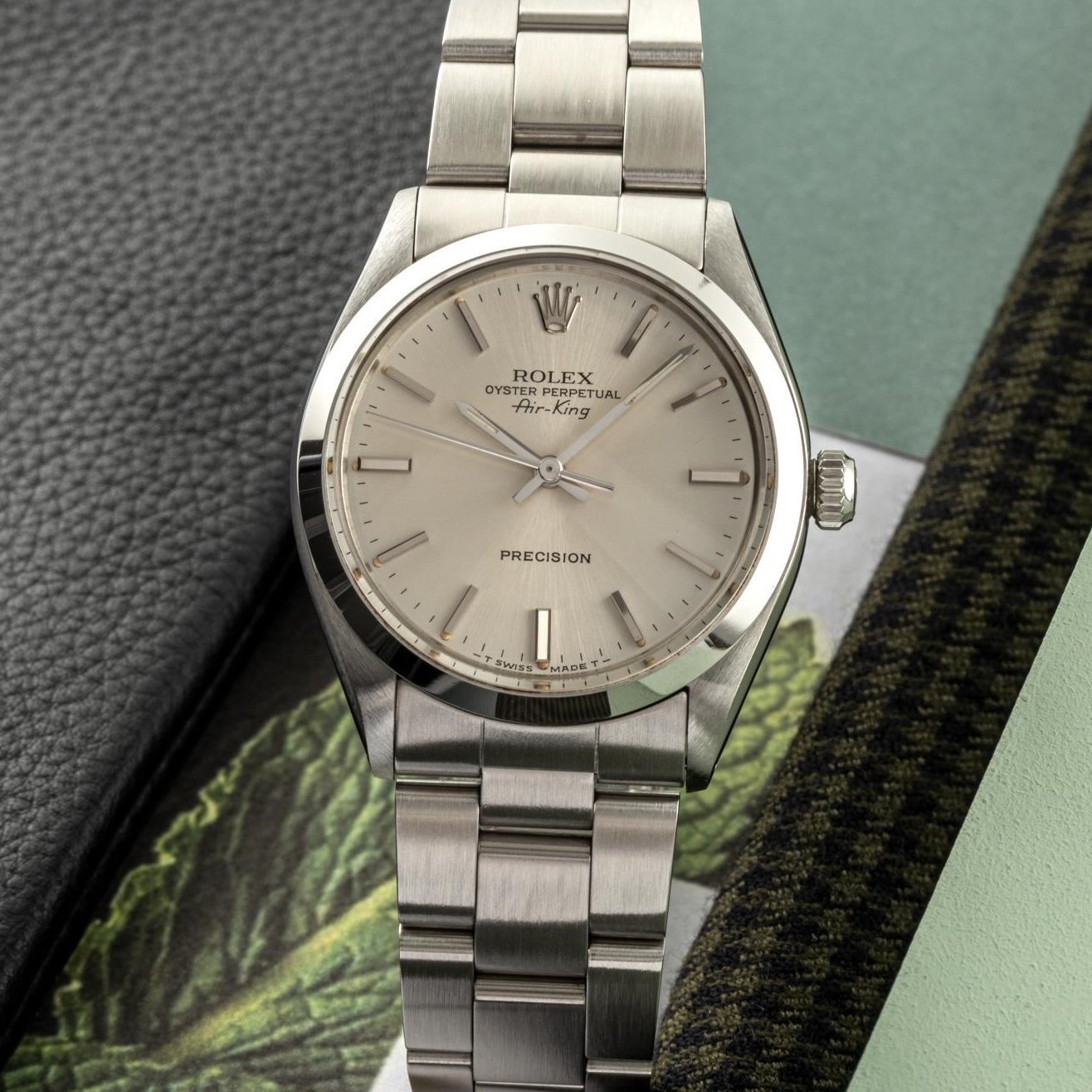
Overall, the general formula was here and the 5500 Air-King was a simple and affordable piece that offered the full Rolex experience without bells and whistles. The smaller 34mm case, lack of complications and absence of a chronometer certification kept the price down compared to the (proper) Explorer and Datejust, but the in-house automatics, standard Oyster bracelet, Oyster case with screw-down crown and overall fit and finish made it a favourite for many. And let’s talk about style. The dial elements were (mostly) cosnsitent at this point with a majority having silver or light dials, baton hands and stick indices (a Rolex aesthetic certainly not limited to the Air-King). As the years progressed, black and slate grey dials became popular as well. Water resistance was now 100 metres.
Corporate Dials
Rolex has a long history of corporate dials, (probably) starting with a “Yankees 1956 World Champions” dial on Yogi Berra’s gold Oyster Perpetual. Rolex actively advertised for logo dial placements and Ref. 5500 became a favourite of businesses looking to provide a Rolex as a luxury bonus, retirement gift and so on. Popular examples today include dials printed with a Domino’s Pizza or Levi’s logo above 6 o’clock, but countless examples are out there from foreign government crests to obscure sporting events. Of course, this wasn’t limited to the Air-King as logo dials were made for the Oyster Perpetual, Datejust, Date and many more, but the Air-King’s classic style and more affordable price seemingly made them best suited for the roll. There was even a very rare Submariner with a Panama Canal dial from 1999. As a quick note, all Mickey Mouse Rolex dials are aftermarket additions as Rolex never sold one from the factory, so buyer beware. Corporate dials are hit or miss with collectors today, but many are still worth more than their conventional counterparts, such as the aforementioned Domino’s 5500.
Below, two examples of corporate dial Air-King 5500 – a classic Domino’s Pizza (image by windvintage.com) and another example with Pool Intairdril Dial (image by bulangandsons.eu)
Calibre 1520 and 1530
In 1957, Rolex introduced calibre 1530 (before 1520) as a “super precision” in-house automatic for the Air-King that didn’t require a chronometer rating. Early pre-chronometer Submariners got this calibre as well, while a relative handful of 1530s got a chronometer rating for specific models. Over the years, it evolved a bit as the butterfly rotor was replaced by a more conventional “half-moon” type, Teflon-coated red gears replaced brass (with the aesthetic we still see today) and the jewel count increased from 25 to 26 for some. All beat at 18,800vph (2.5Hz) and had a 44-hour power reserve. Calibre 1535 was a variant with a date complication (see ref. 5700 below). There were also 17-jewel versions of 1530 and 1520 to avoid tariffs in certain markets, generally the United States.
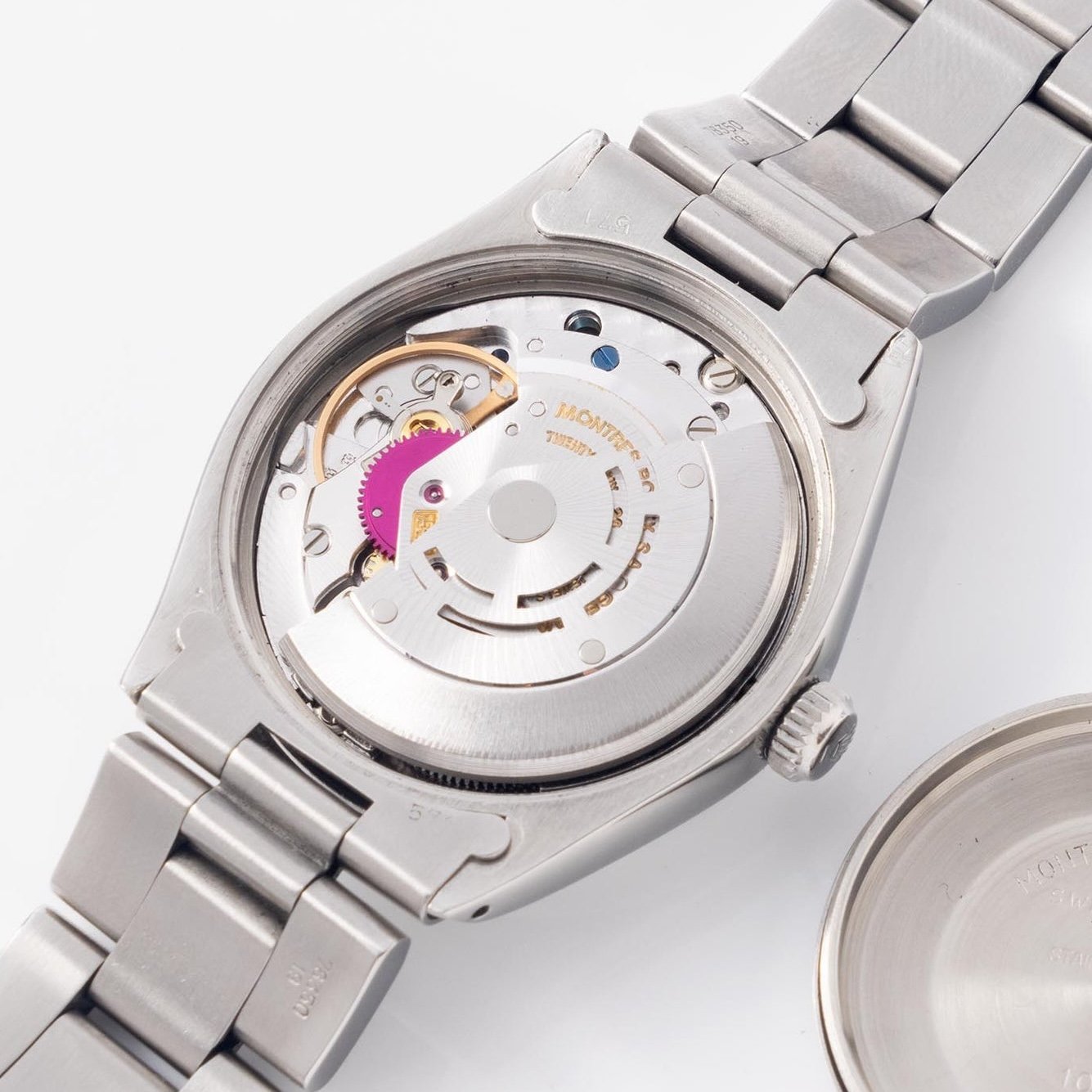
Calibre 1520 was a modest upgrade and also a cost cutting downgrade to 1530 with a slightly higher beat rate of 19,800vph (2.75Hz) and 26 jewels for all movements (save for a possible lower jewel count to avoid tariffs). The power reserve was listed as 42 hours, so a slight downgrade from calibre 1530 and it didn’t use a Microstella regulator like calibre 1530, hence the PRECISION designation even with a higher beat rate. This movement was used in early Submariners as well.
The Air-King Reference 5700, Air-King Date (1959 – 1988)
A cool variant of ref. 5500 is the Air-King Date, ref. 5700, which (as the name implies) simply adds a date window at 3 o’clock under a Cyclops lens and acrylic crystal. These were otherwise the same as the standard 5500 models and similar to the Oyster Perpetual Date models of the time, minus the official chronometer designation. Ref. 5700 had the familiar smooth bezel, while a rarer two-tone (Rolesor) model appeared later with a fluted bezel and gold dial elements (ref. 5701). With the added date complication came an upgraded movement, calibre 1535, although some used calibre 1525 and both were PRECISION movements and not chronometers. Dial colour options were generally silver, black, white and champagne. Curiously, there was also an Air-King Date ref. 6500 with a black dial introduced in 1975.
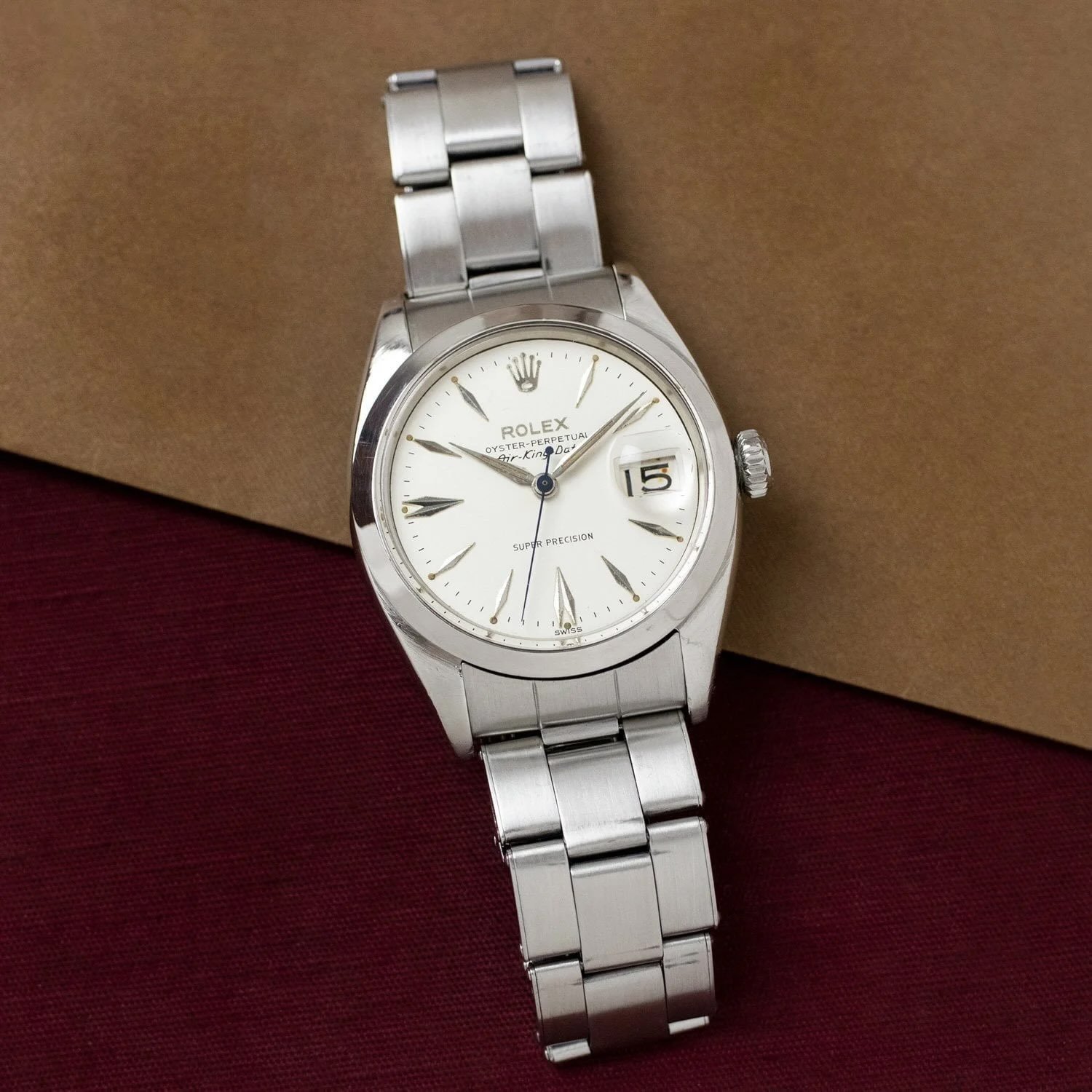
A Few Anomalies
While ref. 5500 was a relatively unchanged and stable run for over 30 years, some weird anomalies were not uncommon for Rolex reference series at the time. In 1960, ref. 5506 (and three other references) debuted with 14-micron gold capping, which is rolled onto the steel unlike traditional gold plating (although the aesthetic was nigh identical). A matching Oyster bracelet came fitted. Then ref. 5501 brought a two-tone Rolesor model with a gold fluted bezel and crown, fitted with a two-tone Oyster bracelet and later a comparable Jubilee. Ref. 5502 had a gold case with a smooth bezel, black dial and Air-King in large script above 6 o’clock. Ref. 5504 had a set of Alpha hands and larger applied indices at 3, 6 and 9 o’clock, all packaged in a larger 36mm Explorer 1 case with calibre 1530. This was not, however, like the earlier 5500 Explorer hybrid.
Other changes include the switch to tritium in the mid-1960s from radioactive radium (recognized with T SWISS T at the bottom) and the introduction of a quickset date for 5700 models in the 1970s.
The Air-King Reference 14000, Contemporary Features in a Familiar Package (1989 – 1999)
From an enthusiast’s standpoint, this is probably the Air-King to get. It maintains much of the character from ref. 5500, but adds a contemporary sapphire crystal and new movement, calibre 3000 (not yet a chronometer). Increasingly uncommon pencil and Alpha hands were now completely gone, replaced with the latest baton hands as seen on the Datejust and others. The drilled lugs were gone as well. Salmon and blue dials joined the pack and dial designs really expanded with different indices, Roman numerals, Arabic numerals at 3, 6 and 9 o’clock (as seen with previous references) and so on. Of course, the familiar and simple Air-King dial layout from before still dominated the series. In 1998, the switch from tritium to LumiNova was complete and T SWISS T changed to SWISS at the bottom of the dial, and Super-LumiNova came to dials soon after that.
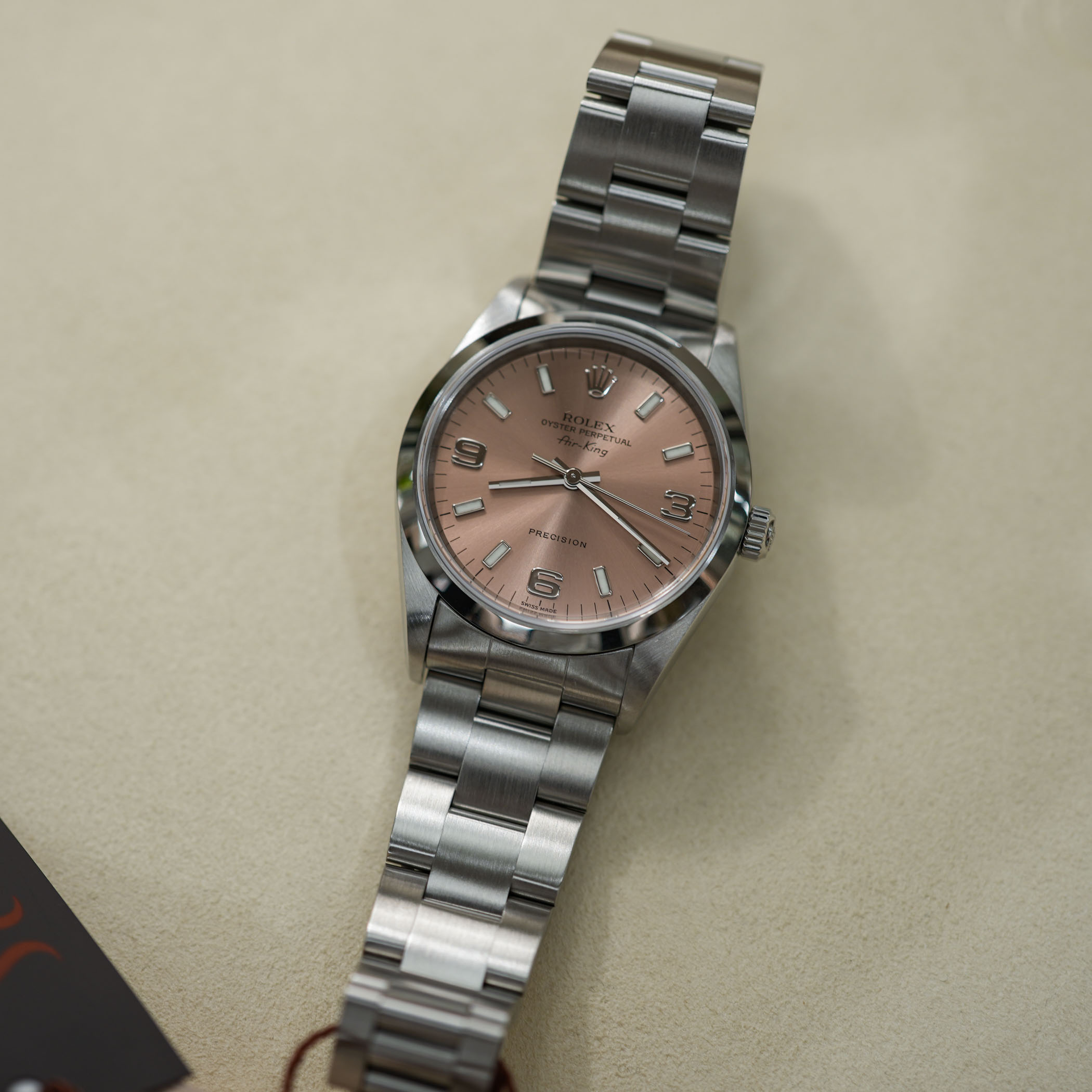
Calibre 3000 was a solid upgrade with 27 jewels, a beat rate of 28,800vph (4Hz) to match the brand’s broader portfolio and a 42-hour power reserve. It was used for some no-date Submariners and Explorers for a time as well. It had a flat hairspring without overcoil and a simplified adjustable mass balance, and was a reliable in-house workhorse until ref. 14000M replaced it in 2000.
The Air-King Reference 14000M (2000 – 2006)
This reference (“M” for a modified ref. 14000) upgraded the movement again, this time with a certified chronometer – calibre 3130. Spec bumps included 31 jewels from 27 and a new Parachrom hairspring. Although 3130 was the first COSC-certified Air-King movement, PRECISION remained printed on the dials. Little else changed overall and both 14000 and 14000M shared dial variances, although as mentioned, Super-LumiNova replaced LumiNova.
The Air-King Reference 14010/14010M with Engine Turned Steel Bezels
Ref. 14010 (1991 – 2001) and ref. 14010M (2000 – 2006) had special engine-turned bezels with fine grooves between polished plates that were adjacent to the main dial indices (double plate at 12 o’clock). This was simply a machined bezel for aesthetics and the models were otherwise identical to ref. 14000 and 14000M.
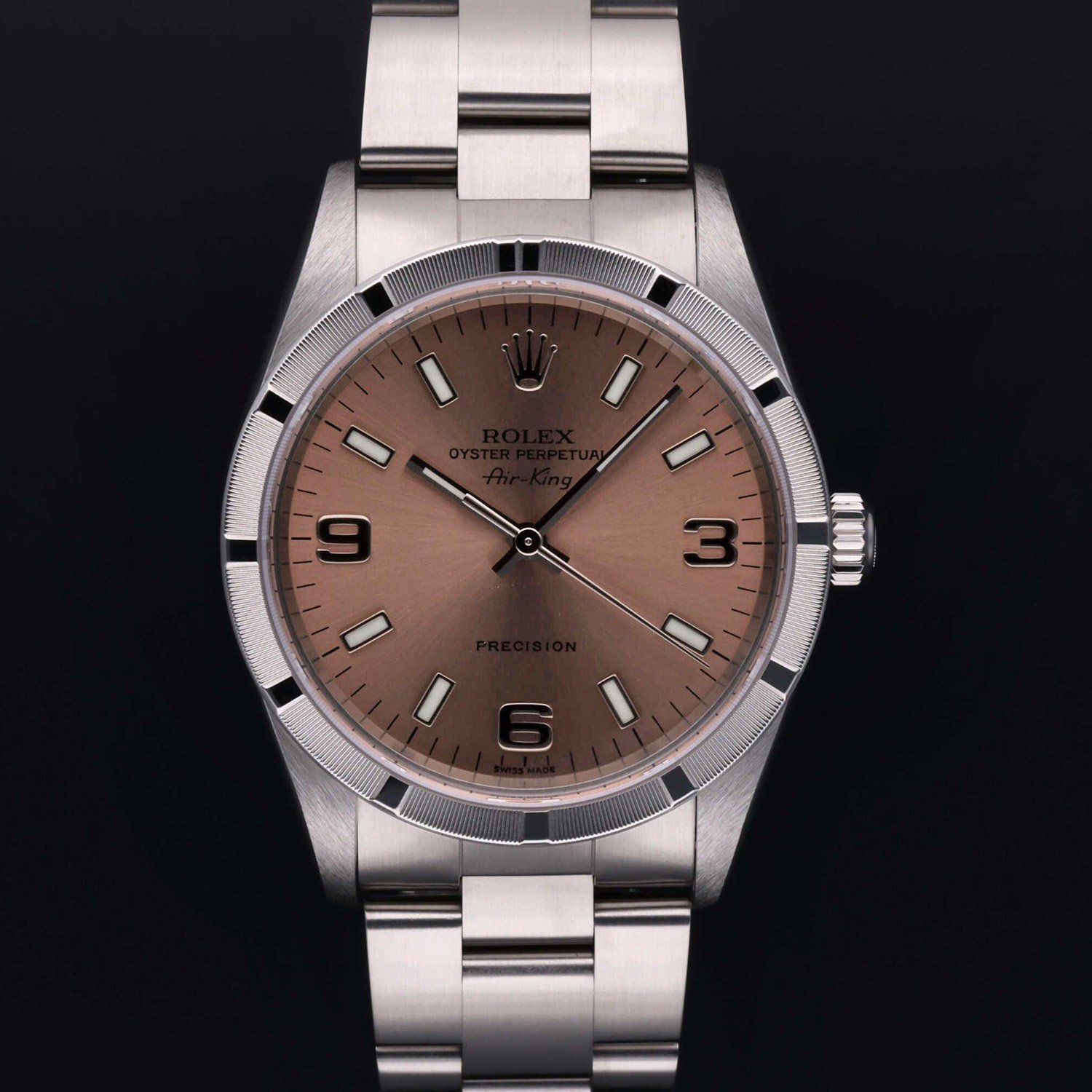
The Air-King Reference 114200, The Air-King Matures (2007 – 2014)
Although we saw a lot of dial variances emerge with the ref. 14000 series, things really went crazy with ref. 114200, the first six-digit Air-King reference (along with 114234) before there was a multi-year production gap. Let’s start small and we’ll go from there. For starters, all dials now had Rolex’s own Chromalight, replacing Super-LumiNova. SWISS MADE was once again standard at the bottom of the dials as well, but dials were now all over the map with colours including black, white, green, blue, salmon and champagne with some having Roman numerals, applied Arabic numerals, exotic dials, two-tone variants and so on. The familiar Explorer setup with applied Arabic numerals at 3, 6 and 9 o’clock became a standard arrangement, differing from earlier models that used this setup, but it was never the norm. White gold baton hands (carried over from ref. 14000) were standard on most models. The case size of 34mm and 100 metres of water resistance did remain unchanged.

PRECISION AND SUPER PRECISION were finally replaced with SUPERLATIVE CHRONOMETER OFFICIALLY CERTIFIED as calibre 3130 (carried from ref. 14000M) was a certified chronometer, but again the curious decision to keep PRECISION on the older 14000M dials was made at the time. Ref. 114234 added a white gold fluted bezel like many Datejust models for a bit of luxury. The humble, simple Air-King had really matured, but it hadn’t quite outgrown its traditional intent (yet). That said, dial variances became so extreme that these could be confused for different Rolex models entirely, although all were time-only with no date (with Air-King still printed in script, of course).
The Air-King Reference 116900, the Return (2016 – 2022)
After ref. 114200 was discontinued in 2014, the Air-King completely left the Rolex portfolio and many wondered if that signalled the end of one of the longest-running models. As it turns out, it was just put back in the oven as a very different package emerged two years later in 2016. A lot of enthusiasts (including myself) believed that the soul of the Air-King began to fade with this newest ref. 116900, a watch that was a world away from the traditional ethos. A different animal entirely. We now had a 40mm case (a massive leap from 34mm), a broader bezel and white gold Mercedes hands almost jarringly replaced the more conservative baton counterparts. In fact, the case was now shared with the Milgauss, along with the movement and antimagnetic inner case. The only thing that made this an “Air-King” was the familiar script on the glossy black lacquered dial, now moved above 6 o’clock as OYSTER PERPETUAL was printed below a green ROLEX under a yellow coronet. Oh, and the lollipop seconds hand was also green with a Chromalight aperture. Again, jarring. The dial only came in black with a mishmash of Arabic numerals – there was the applied 3, 6 and 9 o’clock that we know mixed in with a seconds/minutes timing scale (5 to 55) that was inspired by Rolex’s own dashboard instruments produced for the Bloodhound SSC supersonic car (a British jet and rocket-powered car designed to reach land speeds over 1,000mph). The sound barrier is broken on land at approximately 760mph for reference. The car never achieved its goals and the partnership dissolved.
The movement was upgraded to calibre 3131, which is an improved calibre 3130 from before with a 48-hour power reserve and Paramagnetic Parachrom Blue hairspring. It first debuted in 2007 for the Milgauss and these are the only two models to share it.
The Air-King Reference 126900 (2022 – present)
The newest Air-King 126900 looks much like its immediate predecessor, but there are many differences. The 40mm case is now similar to the GMT-Master II (as the Milgauss was discontinued) with lines a bit sharper, wider lugs, a narrower bezel and a full crown guard (a first for an Air-King). However, the antimagnetic inner case remains. Like virtually all modern Rolexes, the new movement – calibre 3230 – has the latest Rolex Chronergy escapement, which lightens/skeletonizes the escapement and modifies the escape wheel teeth and pallet stones, improving efficiency by 15% and bringing accuracy to +/-2 seconds per day. It wasn’t that long ago when Air-Kings were simply PRECISION models without even COSC certification. A huge jump for the traditionally humble series to say the least.
The black dial is very similar to the ref. 116900, but there are a few subtle changes. First, the 5 is now 05 at the top right, while the applied 3, 6 and 9 Arabic numerals have Chromolight inserts like the Explorer (they were solid on ref. 116900). The bottom index below the 6 has also been removed, making room for a printed coronet between SWISS and MADE.
It’s a bit strange how much the Air-King has evolved, given how restrained Rolex is with its core portfolio. Look at the Explorer, Explorer II, Submariner, GMT Master II, Day-Date, Datejust and so on and you’ll see a consistent design language throughout they’re entire production lives, even with inevitable upgrades. The Air-King maintained that for much of its life, particularly through the 5500, 5700 and 14000 eras, but it’s now a completely different high-end sports watch. That’s certainly not a bad thing, but it does remove some of what made the Air-King unique and special. We already have the Explorer and Datejust, for example, and it almost seems like the Oyster Perpetual has stepped into the Air-King’s role after a promotion. Perhaps I’m too much of a purist, but I don’t see much of an Air-King with the latest generation. A very cool and mature Rolex sports model, yes, but an Air-King?
Collectors and Enthusiasts
One of the great things about the Air-King is affordability for collectors and enthusiasts. A very long production run, especially with ref. 5500 and 14000, coupled with this being an affordable model by design (until very recently) make preowned Air-Kings fairly easy to buy. You can find a nice, well-running ref. 5500 model for less than USD 2,500 (minus the Oyster bracelet) and USD 3,000 will get you a complete, original piece. That’s an exceptional value for a solid, preowned Rolex these days. A nice ref. 14000 goes up about USD 1,000 for a total of USD 4,000 for a piece with an Oyster bracelet, while a ref. 5700 Date model can be had for less than USD 3,500 if you like the Oyster Perpetual Date vibe. If you’re an enthusiast who just wants a nice Rolex experience that won’t break the bank, any of the above will more than fit the bill. In fact, a light polish and service will give you a Rolex that many onlookers will think is new.
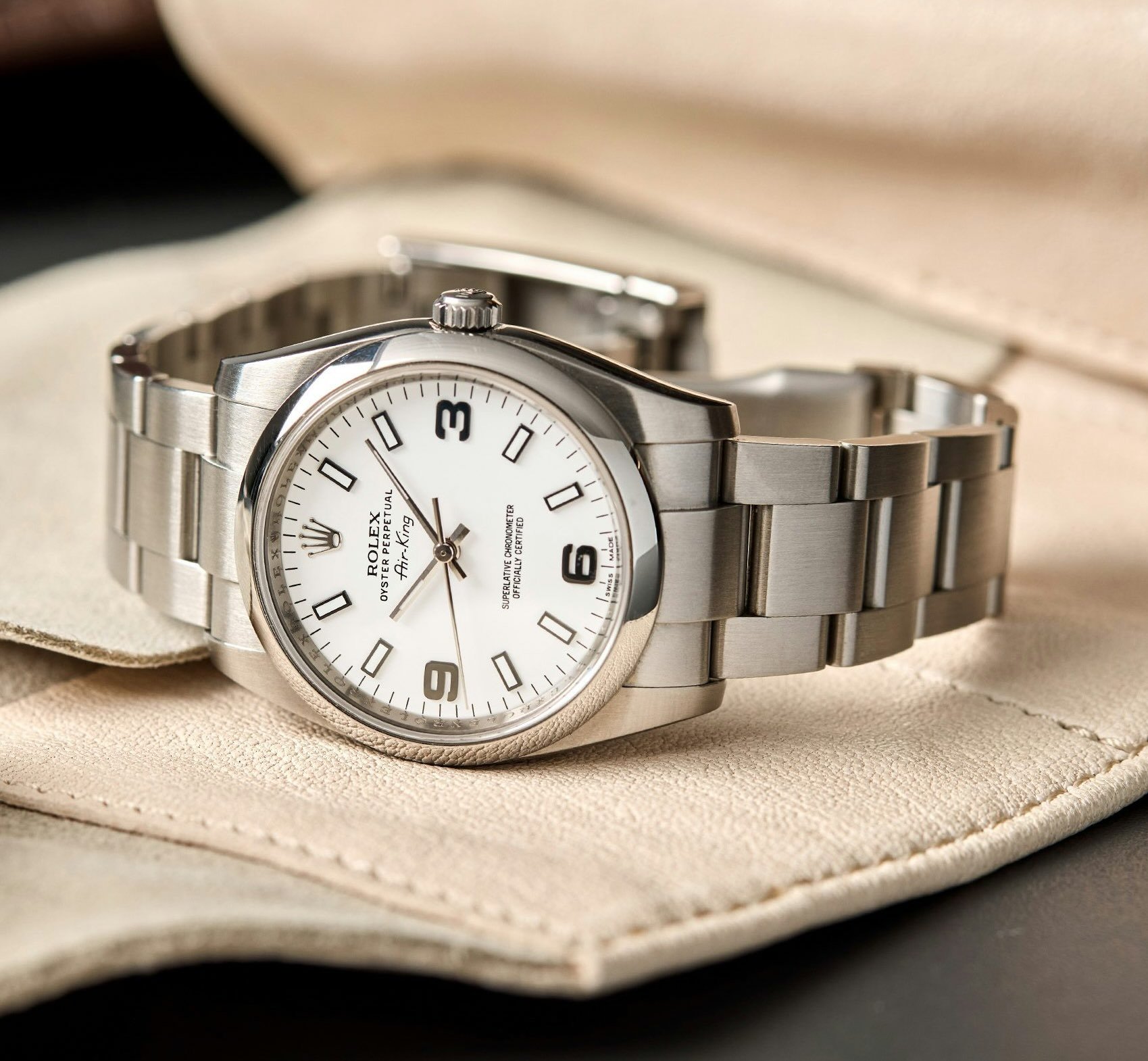
If you prefer something more contemporary, ref. 114200 can be had for less than USD 5,000, while the recent 116900 can be found for less than USD 6,500 and the newest 126900 can be found for around USD 7,500. Keep in mind, the latter two models are now high-end, COSC-certified Rolex sports watches with contemporary 40mm cases and significant magnetic resistance.
Serious collectors, however, are after very early or special models, although even many of those are surprisingly affordable. An original ref. 4925 in nice condition had a high estimate of USD 7,000 at Sotheby’s last September (the final selling price wasn’t listed). For context, a nice Explorer ref. 1016 from the 1960s will set you back around USD 15,000 and that’s a standard model with early(ish) features that had an almost 30-year production run. Special models, like a Domino’s Pizza 5500 can go north of USD 10,000, while a “double red” 5500 can be even more. If you can find a 5500 Explorer hybrid, you’ll need even deeper pockets. However, just look at an early Paul Newman Daytona and you’ll realize just how affordable these are for rare, vintage Rolexes.
I’m again torn by what the Air-King has become. On one hand, it’s now a thoroughly modern, high-end sports watch that can play on the same field as any contemporary model today. On the other hand, it’s just not the Air-King that I grew up with with an established look going back to the mid-1950s. It kind of reminds me of the recent electric Ford Mustang. Cool and contemporary, but it’s just not a Mustang anymore. But who am I to overly criticize a model that’s now among the brand’s best steel sports watches?
We’ll always have a smorgasbord of traditional preowned Air-Kings on the market with amazing price points, so there’s truly something for everyone. Some may say that the Air-King is the lowly entry-level Rolex, which may have been true in the past (certainly not the case today), but that’s not a bad thing. One of my favourite vintage models is the Oyster Date with a hand-wound movement, on par with early Air-Kings for the “entry-level” tag. As far as I’m concerned, a nice ref. 5500 Air-King provides just as much of a Rolex experience as a ref. 1016 Explorer – and I’m sticking with that statement.

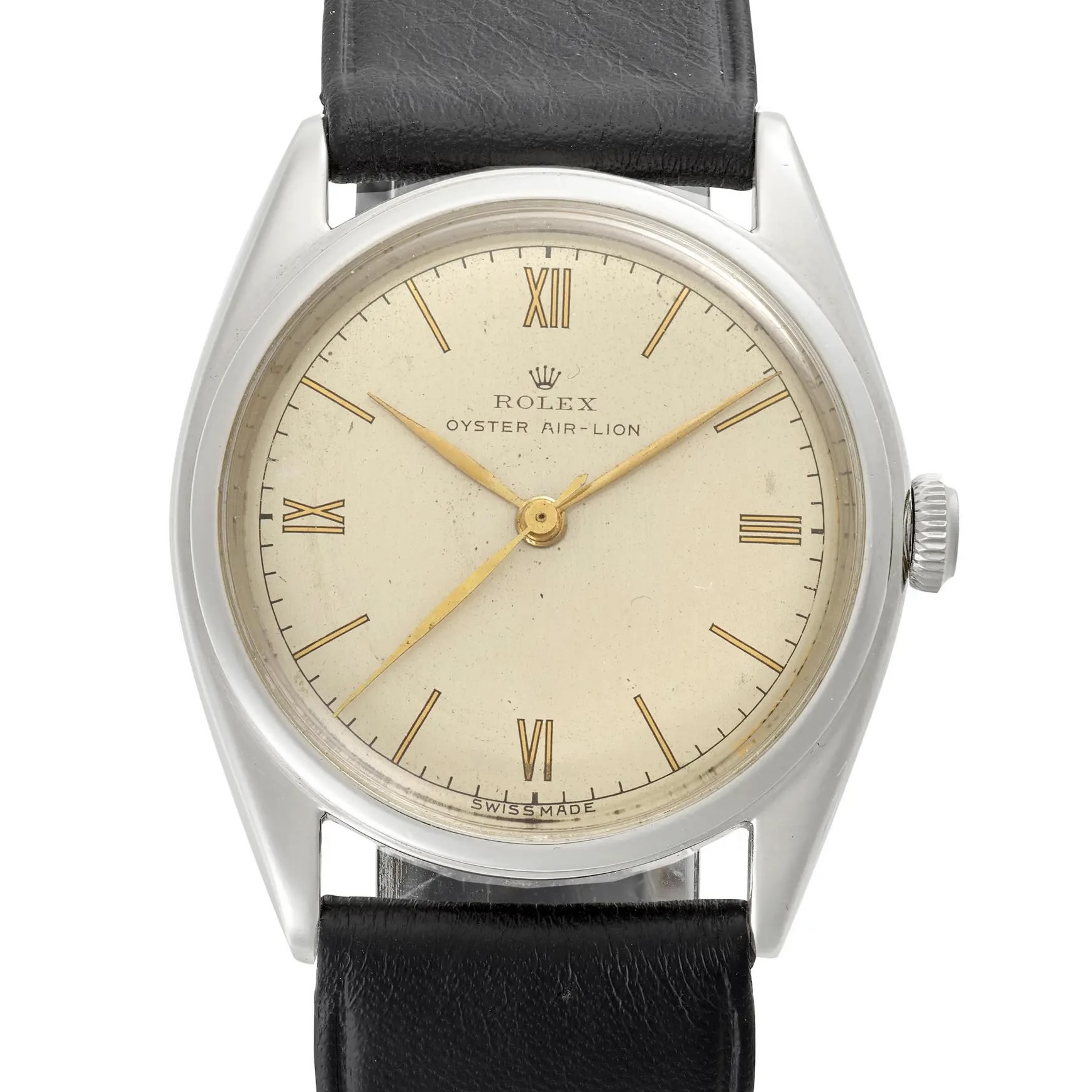
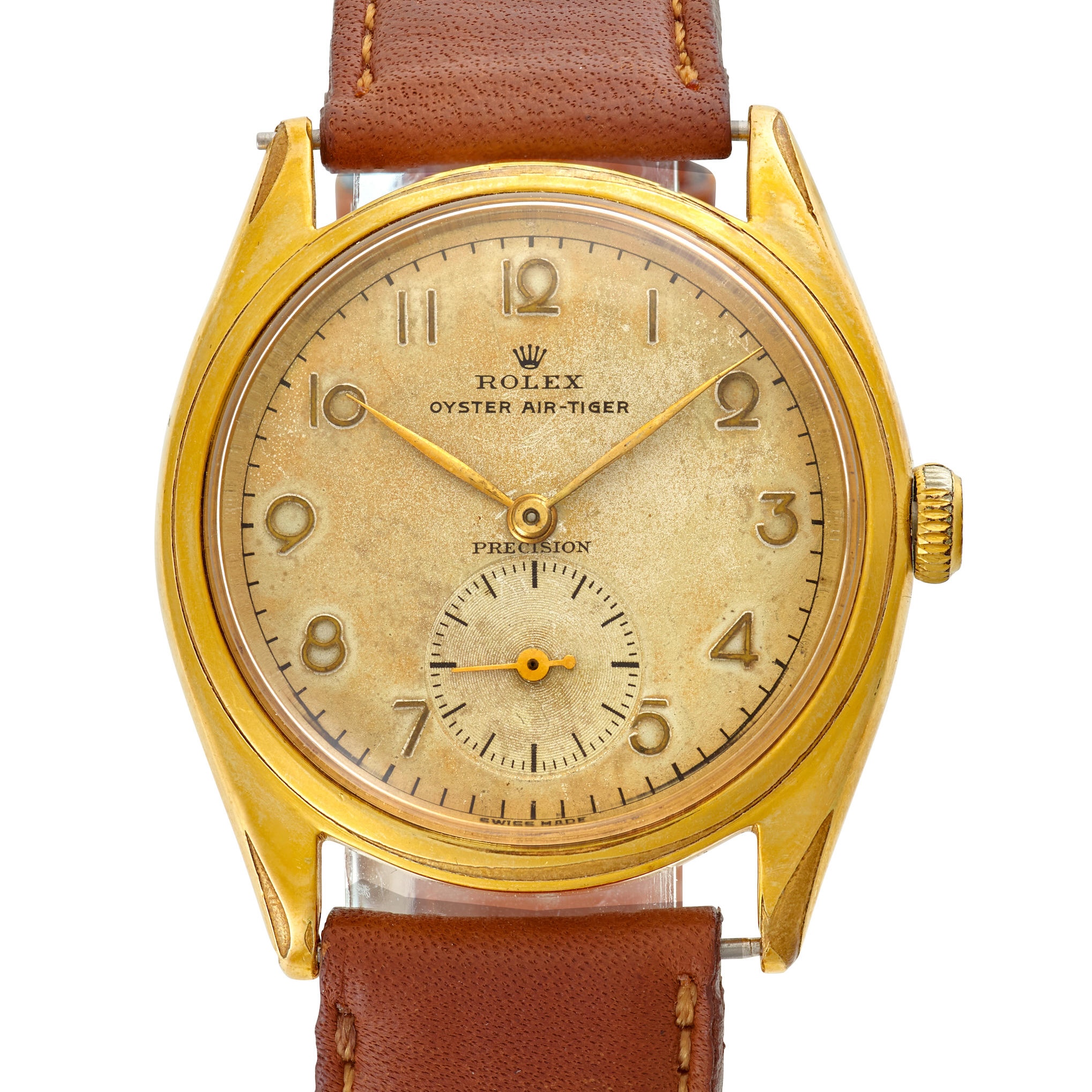

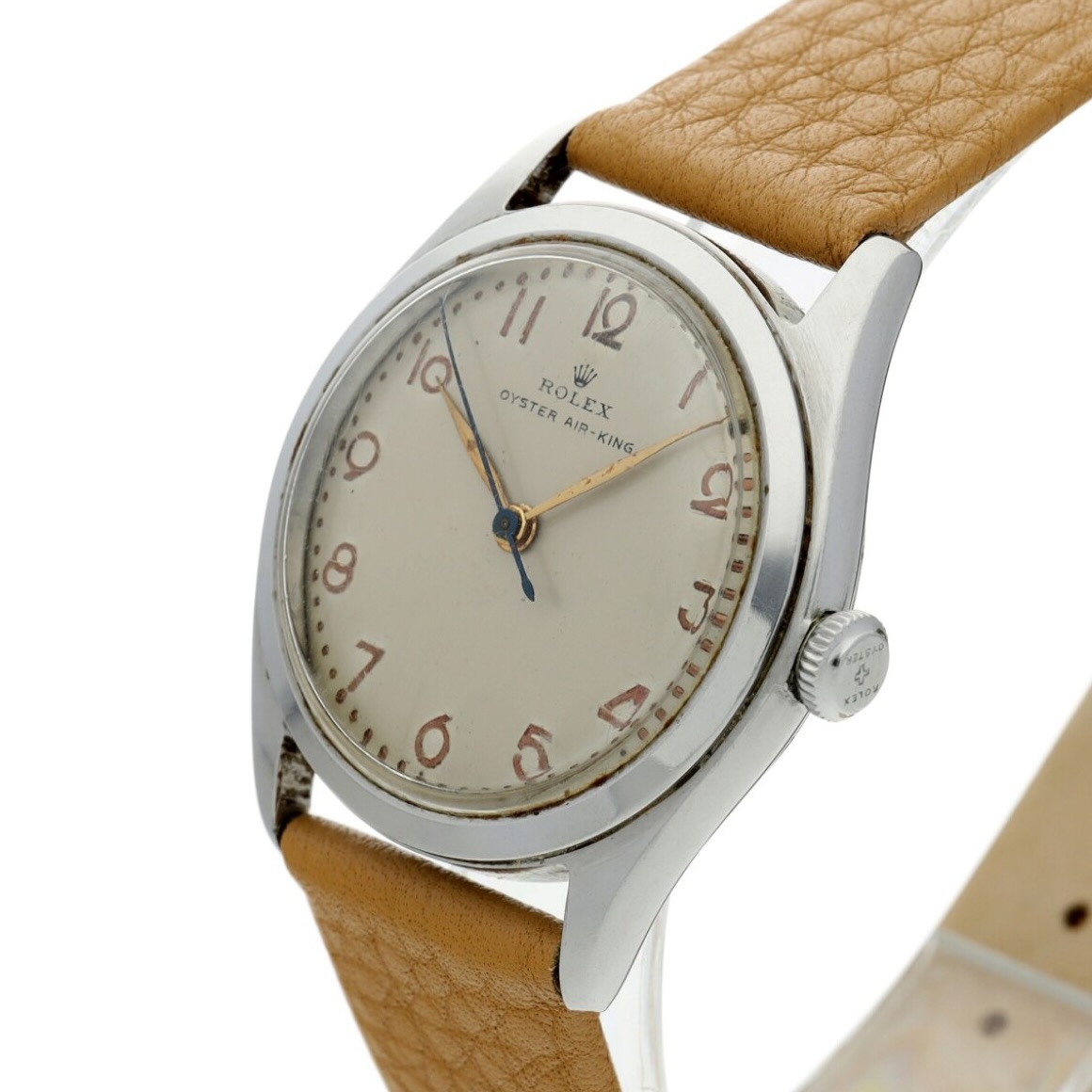
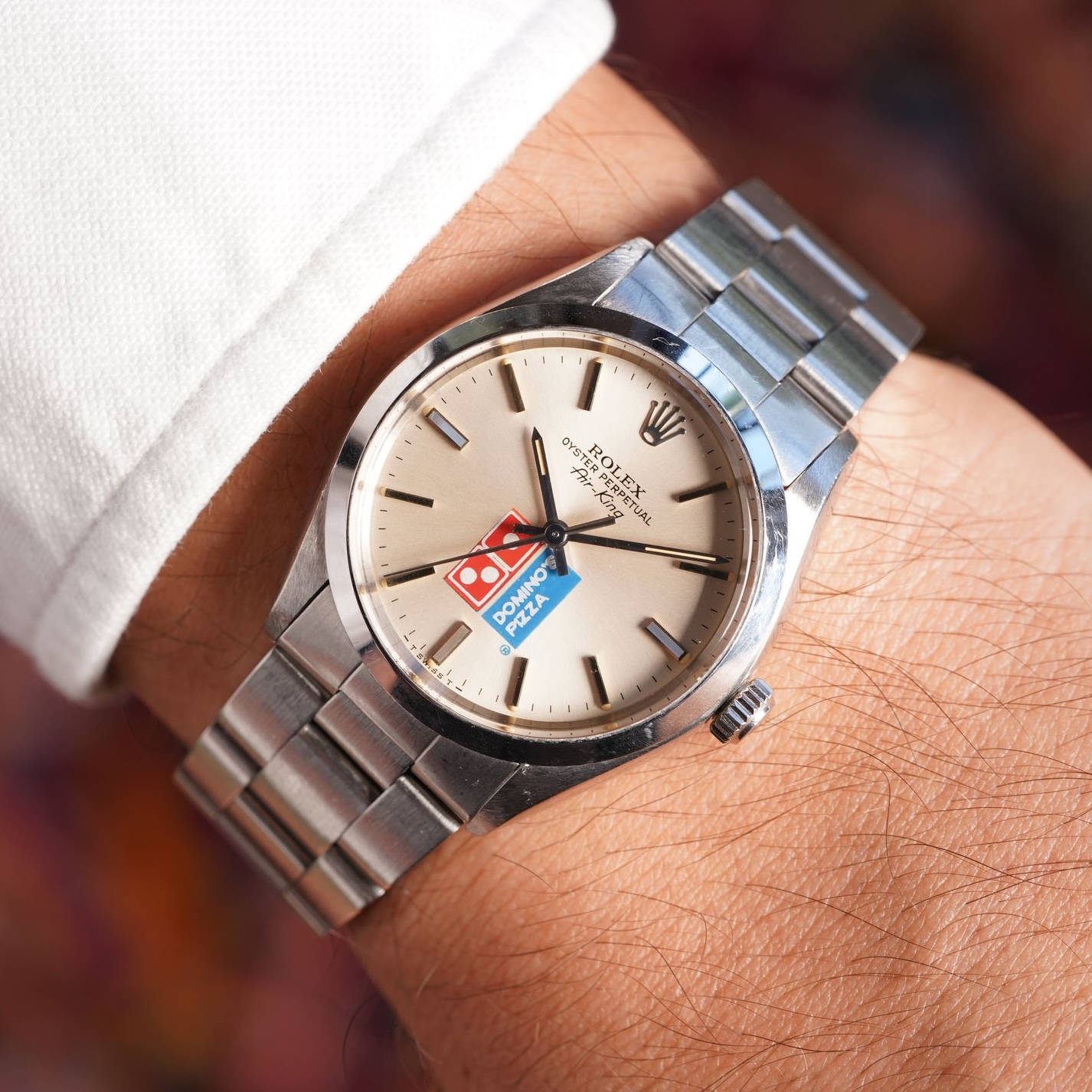
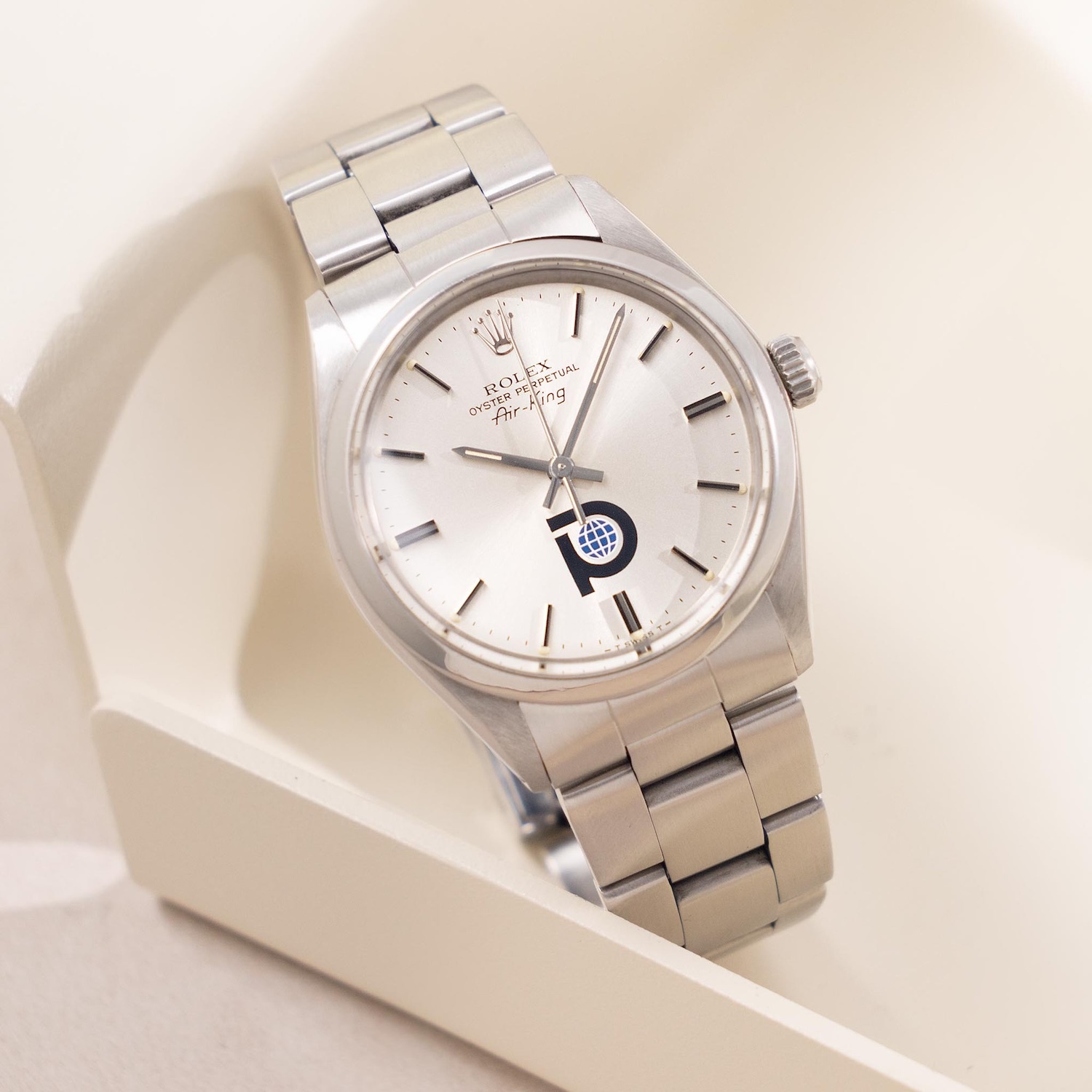
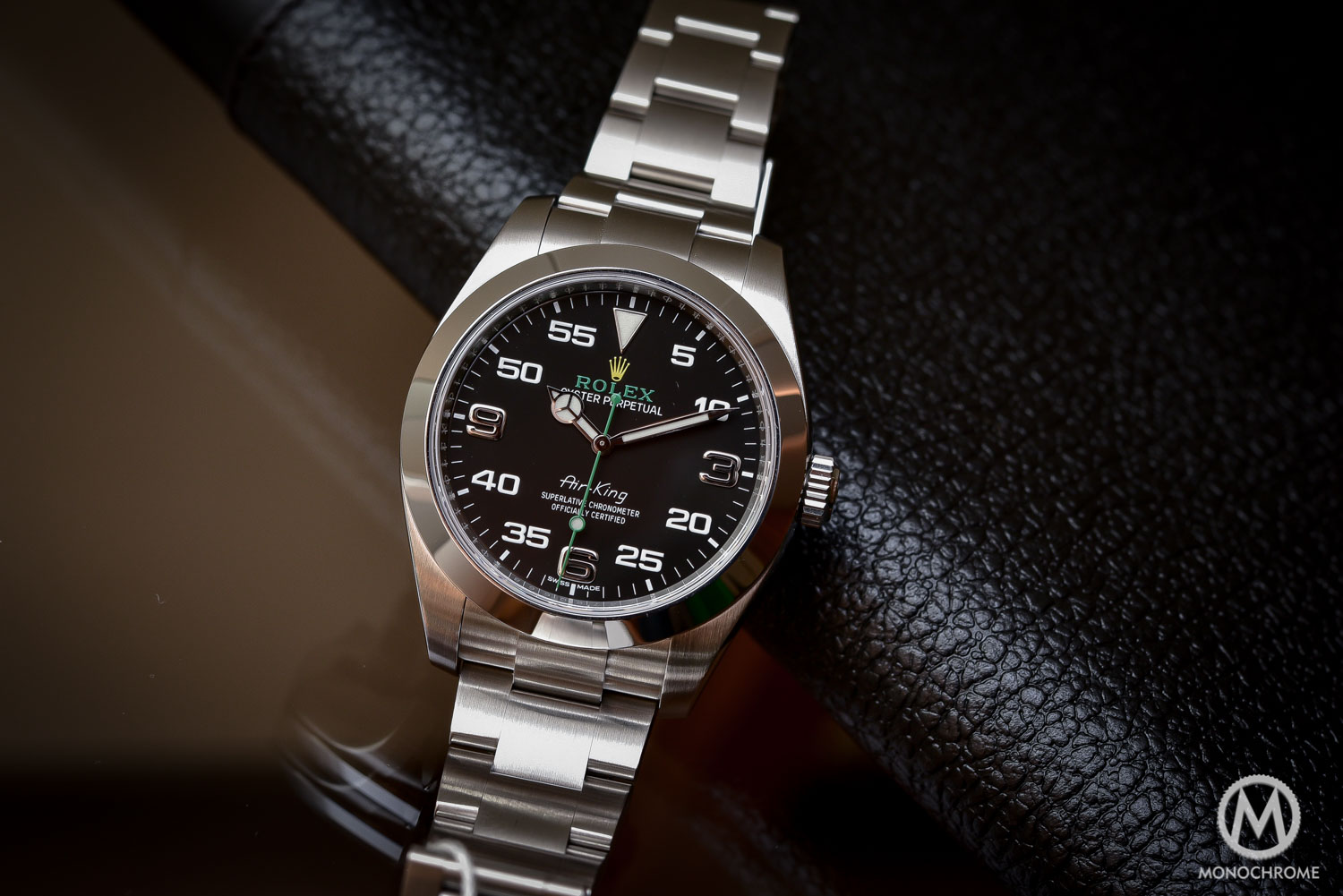
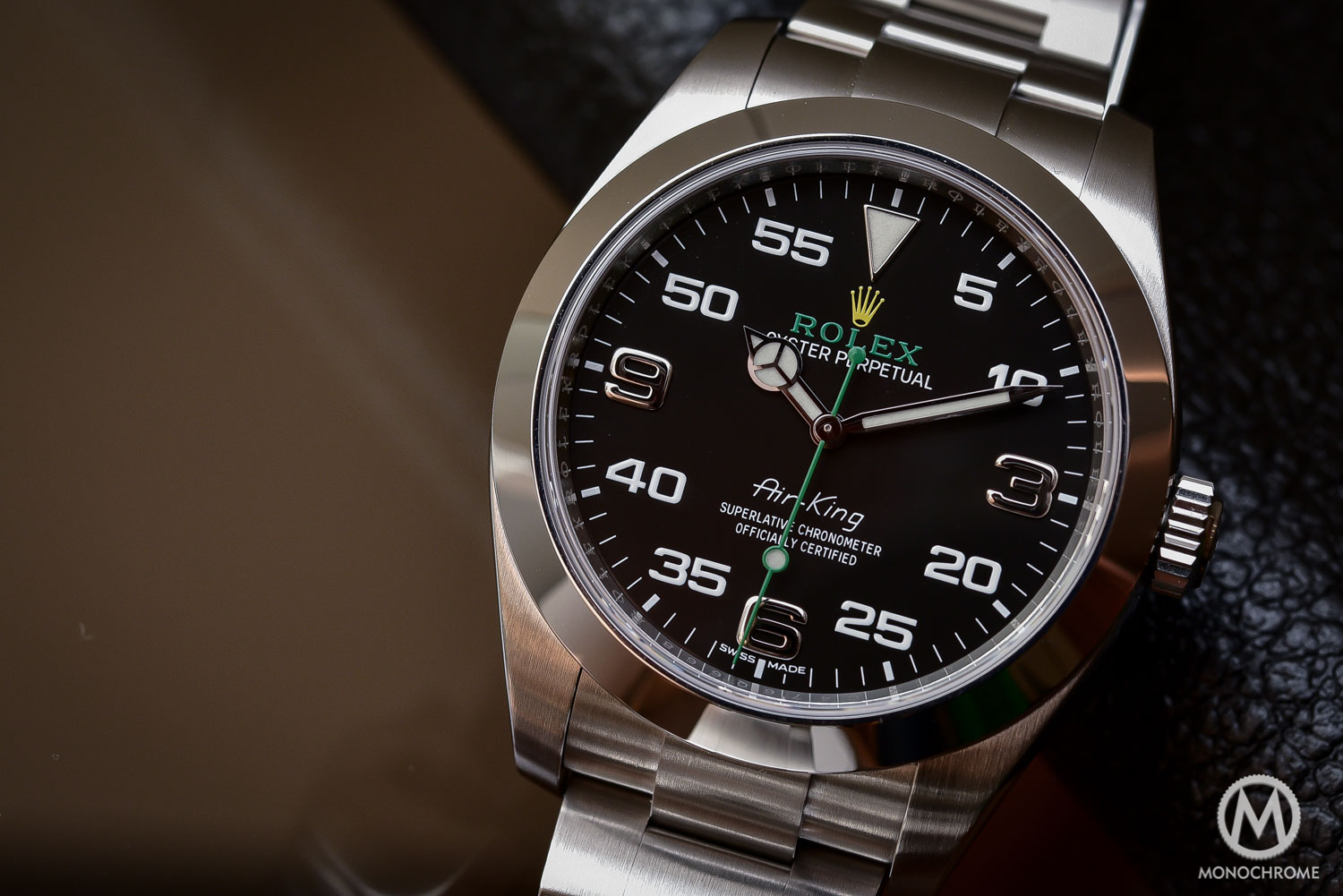
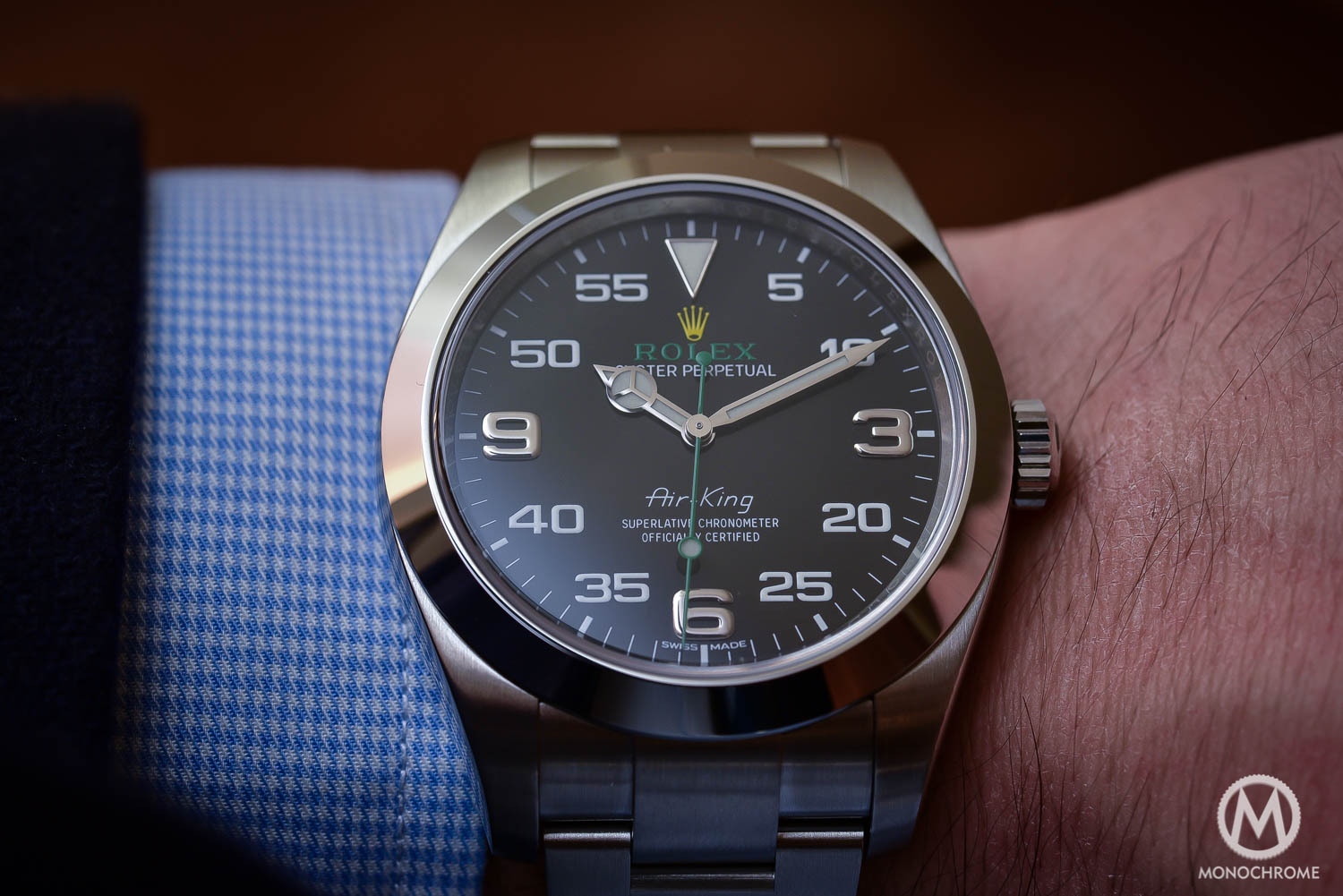
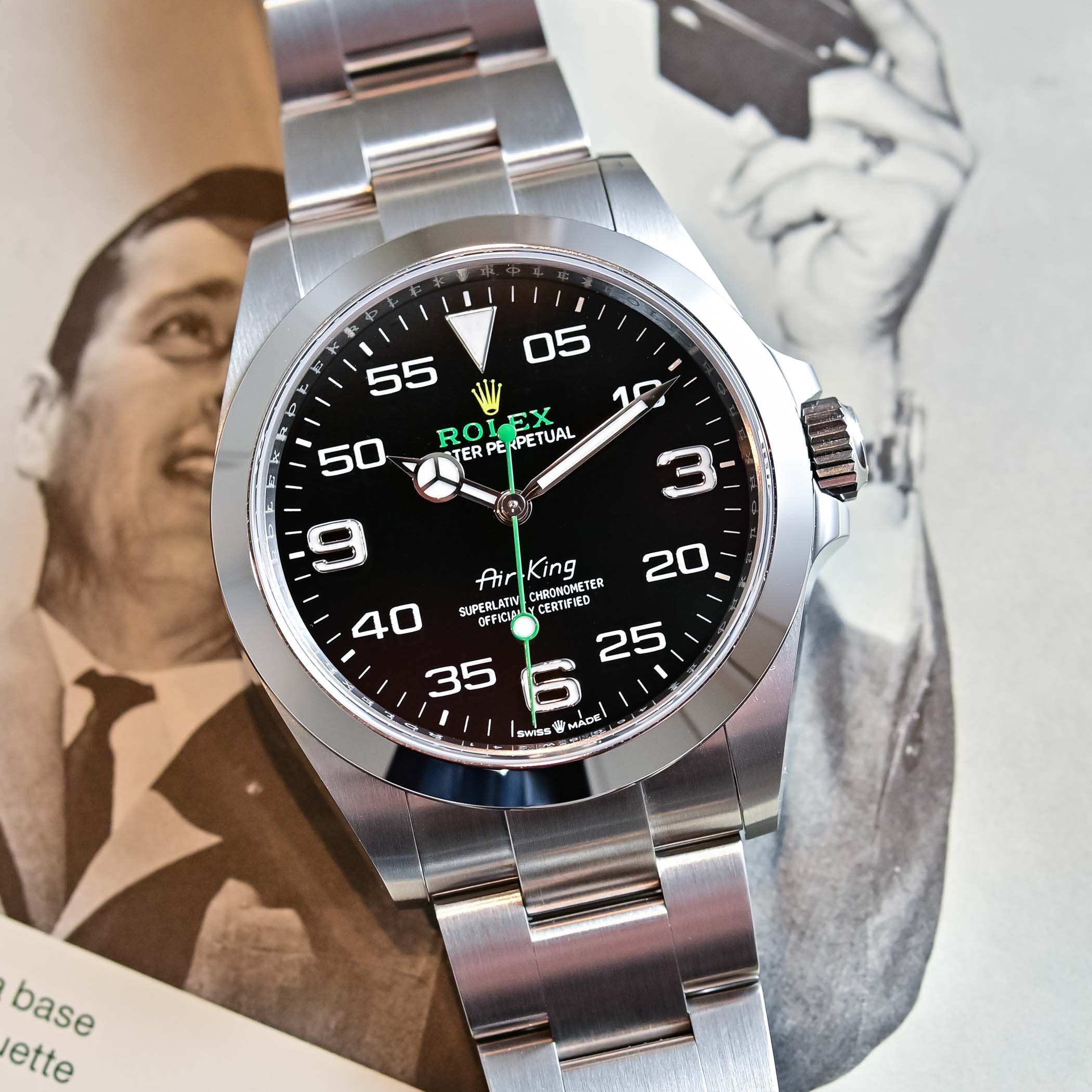
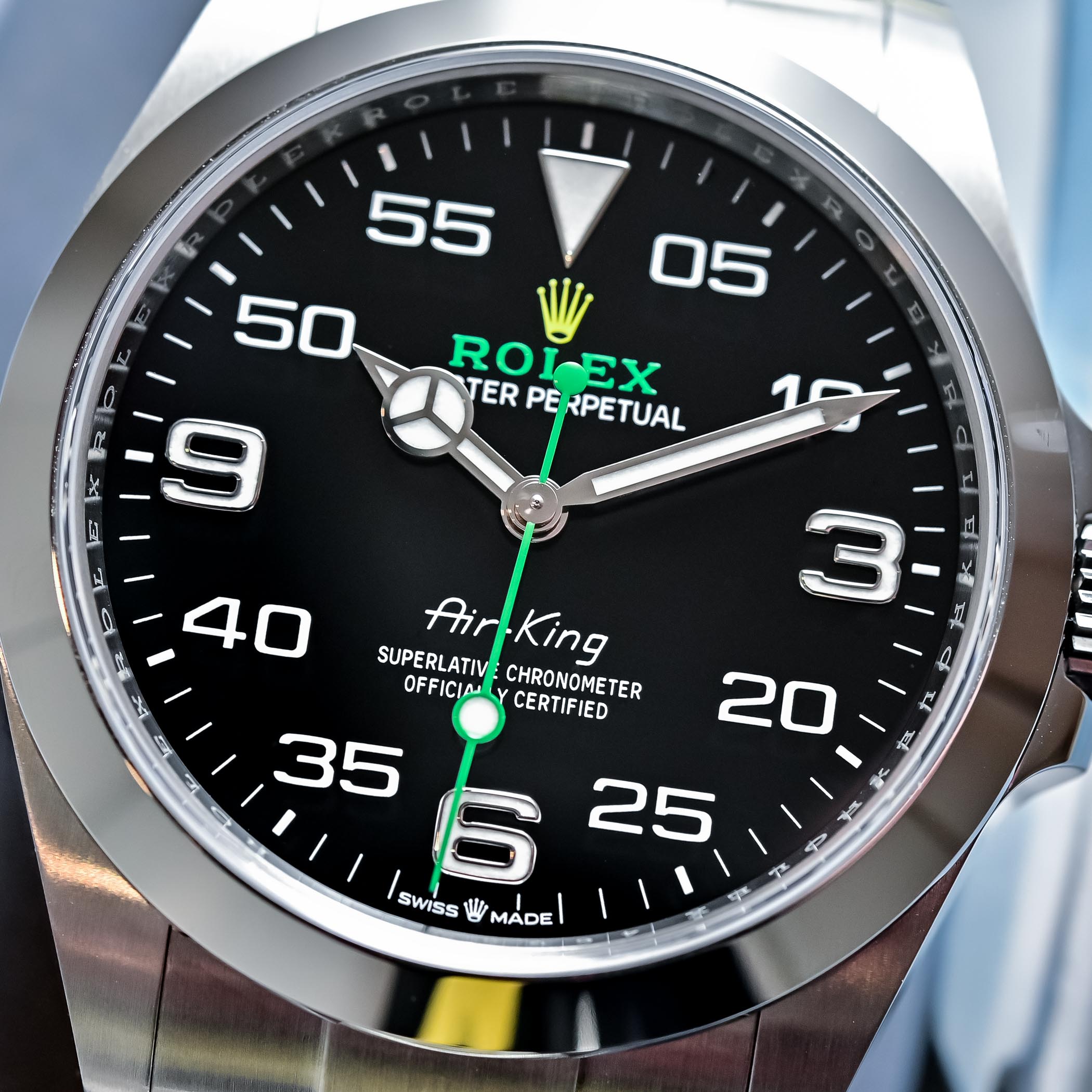
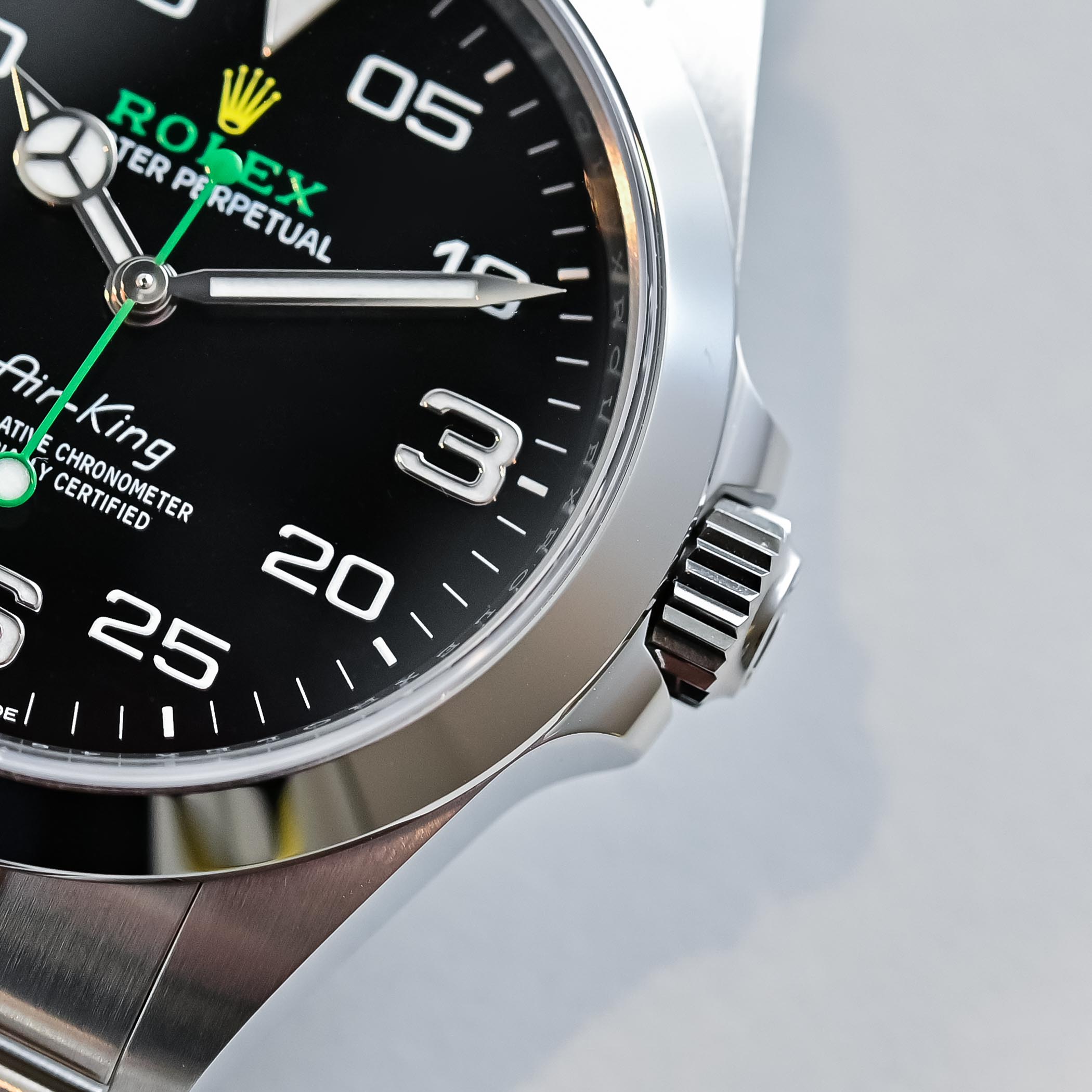
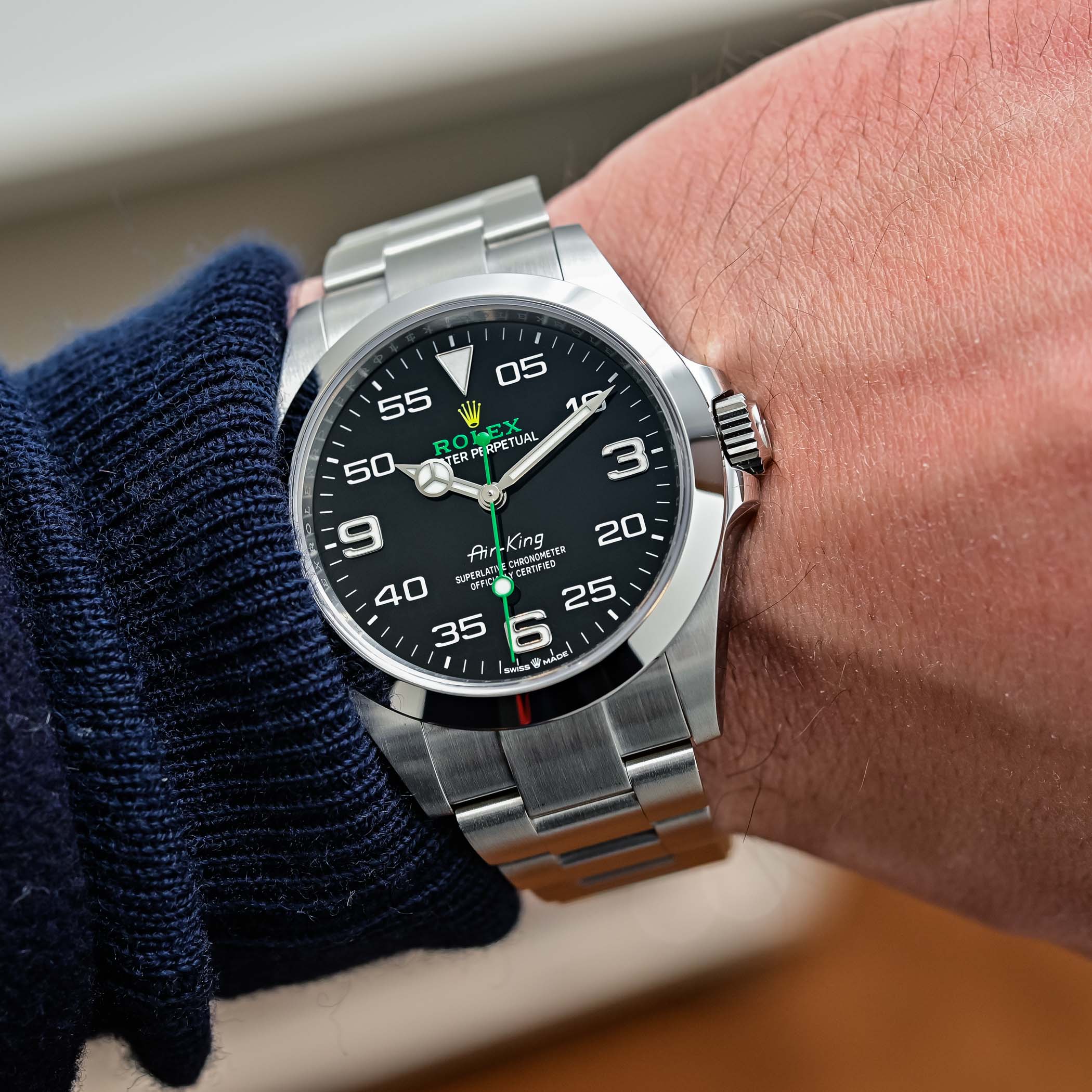
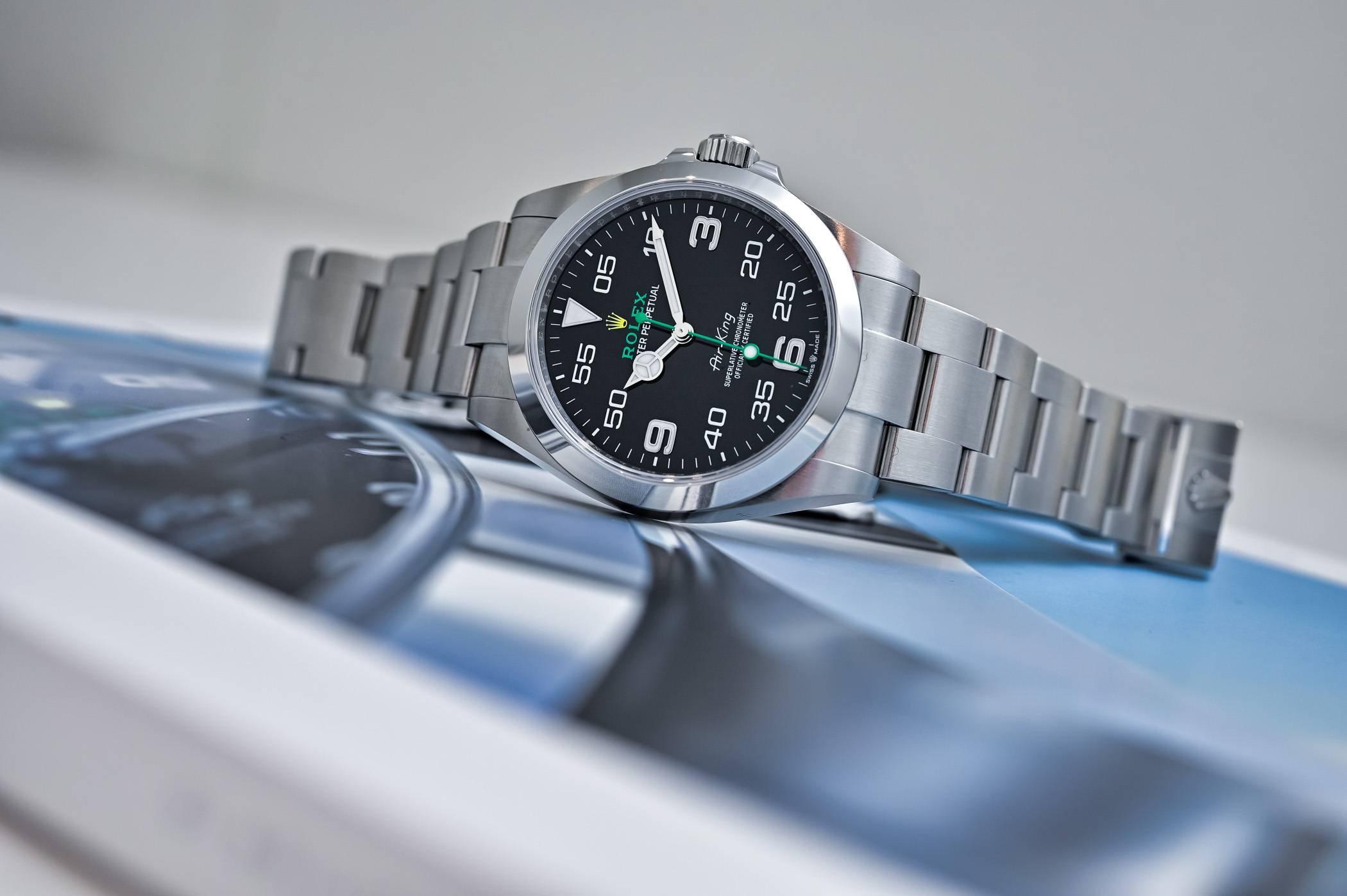
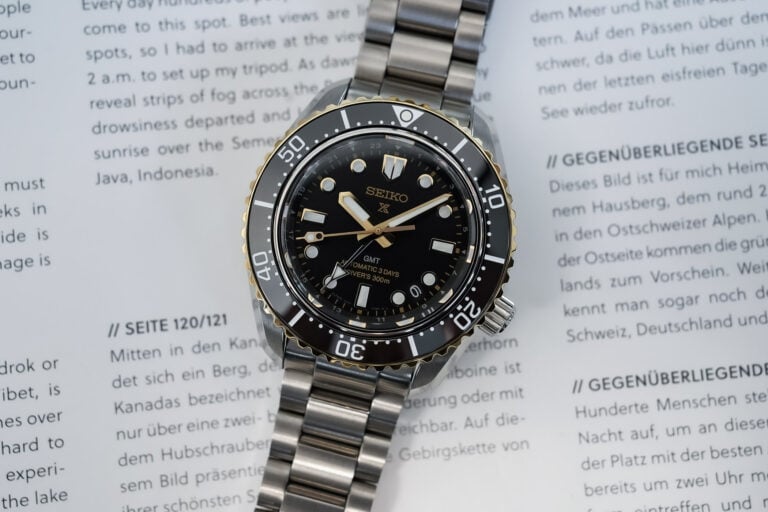
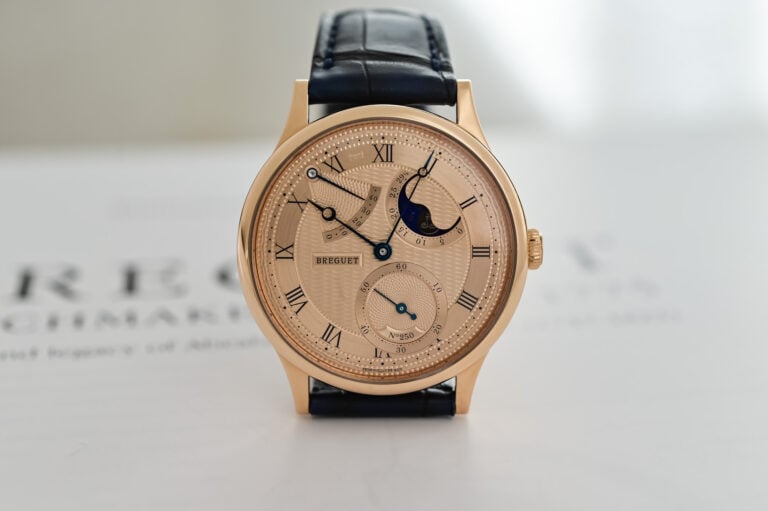
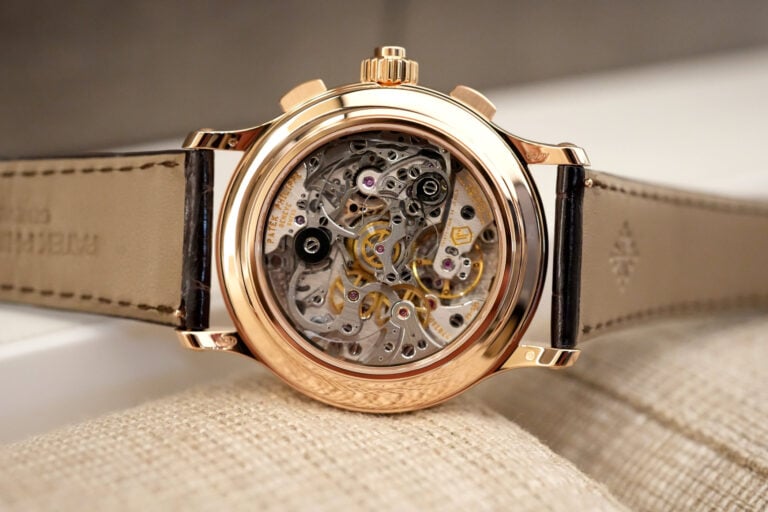
1 response
Picking up mine Wednesday 😉